You want to buy a Belly Boat (also Belly Boat) or have always been interested in this kind of locomotion on the water and the associated fishing? Then you can expect in this article a wealth of information on the purchase and operation, the most important accessories, tips for successful fishing with this vehicle, as well as recommendations for suitable fish finders for belly boats. In detail, we clarify questions about:
Table of Contents:
- What is a belly boat?
- Belly boat types: Are there differences?
- What are the advantages and disadvantages of each type of boat?
- Is a wide range of accessories for belly boats recommended?
- Which fish finder should I choose for my belly boat?
- Buying a belly boat: Our recommendations.
- How to fish with the belly boat?
- Safety: top priority for the Belly Boat?
- Final consideration: fishing with the belly boat.
Undeniably, fishing success on most waters can be significantly improved by using a boat. Possible hotspots that are inaccessible from land can be fished without any problems. The belly boat occupies a special position among the means of transport that are of interest to us anglers. It can still be used where classic watercraft can only be used with great effort or practically not at all.
1. What is a belly boat?
Accommodating such a quantity of luggage on a ¾ square meter, bulging rubber tube is a challenge. Careful planning, even when choosing the boat itself, is therefore a must. In practice, of course, it is easier if the manufacturer has already answered the relevant questions. These include, for example :
- How to attach rod holder, sonar transducer or fish finder to belly boat?
- And where can the necessary utensils such as the fish finder battery, connection cable, etc. be stowed?
But more about that later.
Anyone who wants to buy a belly boat may encounter stressed dealers. Belly boats currently enjoy great popularity because they are relatively inexpensive to purchase, as well as easy to handle in one-man operation. A larger trunk for transport is sufficient. And at home you can quickly find a corner where the device can be stored folded.
In the classic belly boat, which usually comes in a V or U shape, the angler sits more or less deep in the water (depending on the model). With flippers on his feet, he moves forward and has both hands free for fishing. What seems desirable at first glance is disadvantageous for the angler during longer fishing trips and cold water. The permanent immersion of the limbs in the water, quickly leads to hypothermia. This should not be underestimated. A wader (neoprene) is therefore mandatory as an accessory, even if that drives up the cost somewhat.
-
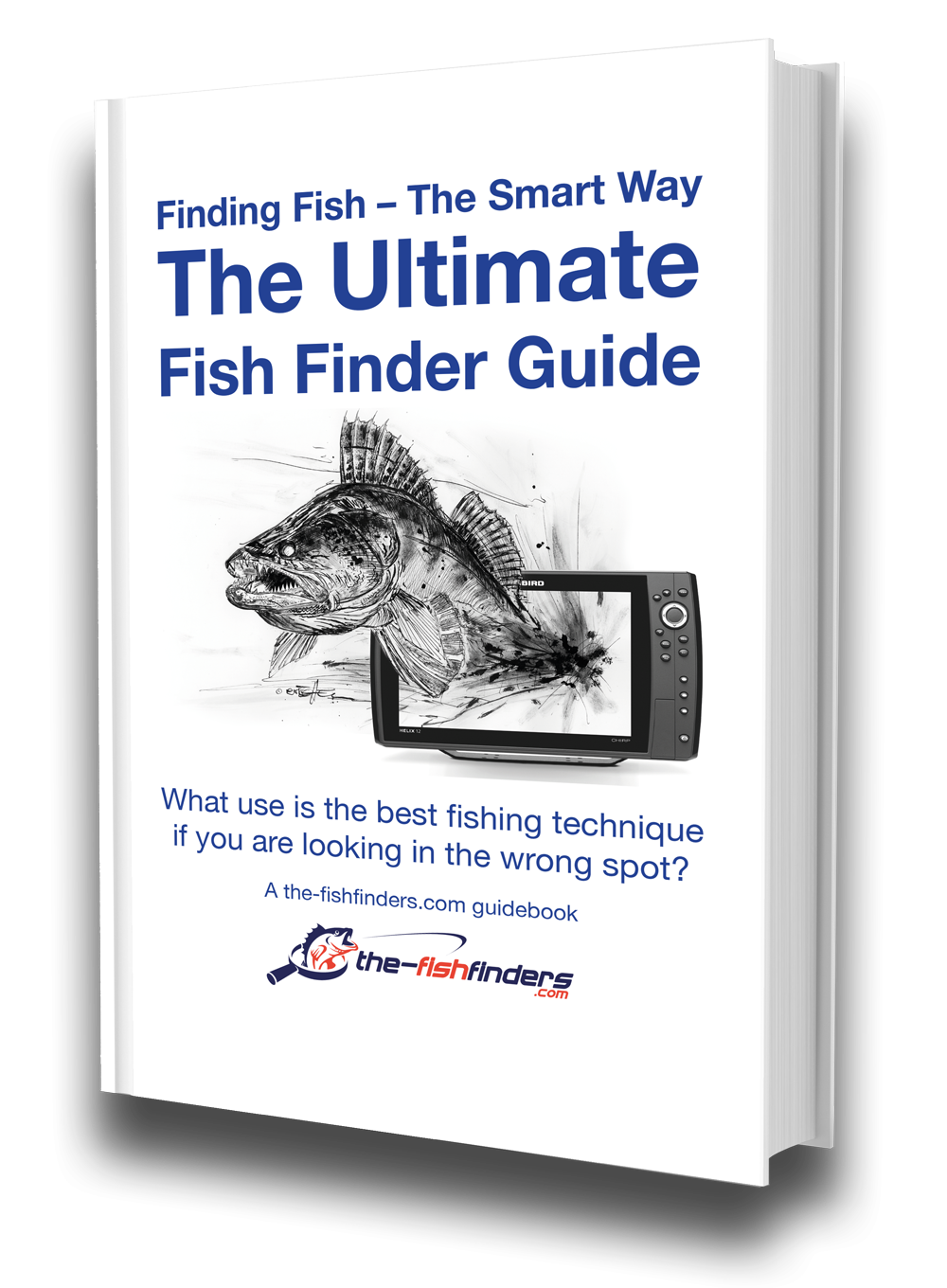
The Ultimate Fish Finder Guide
Download 40 pages for free now
Reviews ( 17 )
But do not worry, belly boat designers have also addressed this issue. That is why there are types of boats on the market that can be used in “dry” condition. This requires a different type of propulsion, mostly with oars or else with an electric motor. The advantages and disadvantages of the individual types of construction and the special features of one or the other model are explained in more detail below.
2. Belly boat types: Are there differences?
All belly boats that follow the V or U shape have more or less the same design principle. They differ only in size, materials used and equipment details. All three factors determine the price, which may well be in the high three-digit range. In addition, another type has established itself, which probably arose from the hype surrounding SUPs. It is characterized by a platform design that allows even standing fishing on the water.
The third type in the bunch is an old acquaintance boat-wise with two inflatable outriggers. This belly boat is marketed as a catamaran or pontoon type and has its own fan base. With the decision to buy a belly boat, you can not avoid a closer look at the different design principles.
3. what are the advantages and disadvantages of each type of boat?
So in the following chapters we will go into more detail about the differences and advantages and disadvantages of the three different types of belly boats. Starting with
3.1 The classic (V- or U-shape)
This can typically be recognized by its inflatable boat silhouette. It does not have any fixed components and, like its air-filled relatives in the multi-chamber system, is merely inflated. This facilitates handling immensely, but cannot always meet the stability requirements (and here especially in the seat area), especially with inexpensive models.
This type of boat is propelled by leg movement with the flippers. Depending on the design, oars are also supplied. Due to the design specifications and a low center of gravity, the angler sits in the water only with the legs or up to the buttocks. A heat-protective waders prevents hypothermia. Equipment and carrying capacity are the cost drivers for the purchase. De facto, you can buy such a belly boat already for 200 €. For about 500 € you are in the middle class.
Those who choose this type will have to get used to the obligatory waders, but in return can move safely on the water with a rather low center of gravity. However, the fin drive is less suitable for longer distances. The maneuverability is likewise not the possible optimum. On the other hand, you don’t have to worry about the boat’s susceptibility to wind.
If you look at the sales figures, this type is the absolute favorite for many. However, you should look very carefully in the mass of offers to find your needs and wishes in the model of choice in the long run.
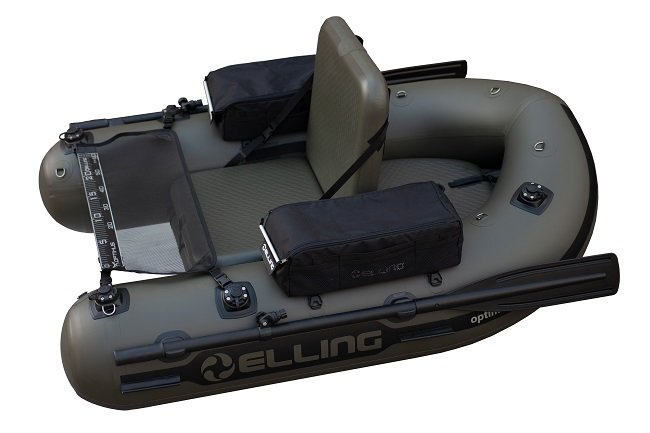
Advantages:
- Inexpensive purchase possible,
- easy handling,
- problem-free storage,
- both hands free for fishing,
- low center of gravity on the water and
- less susceptible to wind.
Disadvantages:
- Hypothermia possible (waders necessary),
- Stability restrictions in the seat area possible,
- Maneuverability not optimal,
- Scouring effect due to use of fins,
- Extension options depending on equipment and
- usually additional equipment (waders, fins) necessary.
3.2 The flat former
As the name suggests, this type of boat has more similarity with an inflatable SUP (Stand Up Paddle Boat) than with a classic Belly Bοot. Its relatively large bearing surface on the water increases its stability and thus allows standing fishing. Fins propulsion is possible with this design as well as locomotion with oars. These are usually included in the delivery. Some models even bring the transom for motor mounting.
Apart from this device, which is inserted into suitable rubber eyelets during assembly, this variant does not require any rigid components. It is therefore only inflated and can be conveniently folded again for transport. When sitting elevated above the waterline, the legs hang in the water – so appropriate thermal protection will be necessary in case of doubt. In terms of price, we are in a range from 600 €.
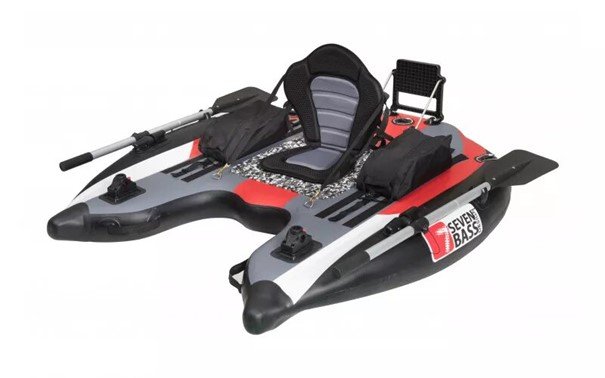
Advantages:
- Very stable water position,
- standing fishing possible,
- high payload,
- directionally stabilized (three fins in the bottom area),
- optional drive type,
- both hands free for fishing (fin operation),
- easy handling as well as
- trouble-free storage and transport.
Disadvantages:
- Additional costs (waders, fins),
- high acquisition costs,
- higher weight,
- larger transport volume and
- also not in the program of all manufacturers.
3.3 The catamaran
With two separate hose chambers on the left and right, the catamaran type, which can also be found under the search term Pontoon Belly Boat, is visually further away from the classic. Constructively, a steel frame (partly hardened aluminum) is used here, which is plugged together during assembly. This subsequently provides the support for the central seat unit and the footrests on the left and right. This makes dry operation possible and the entire vehicle is very stable in its basic construction. This creates the possibility of all desirable extensions such as motor operation, battery storage, rod holder and fish finder to attach without problems.
The catamaran type is rowed or moved by the electric motor. It is very stable on the water. Due to the higher seating position, it gives the angler a better overview. The outriggers guide the boat course stable and maneuverable at the same time. Small contact surfaces in the water mean less friction, so that even longer distances can be mastered with less effort. However, a somewhat higher susceptibility to wind must be accepted.
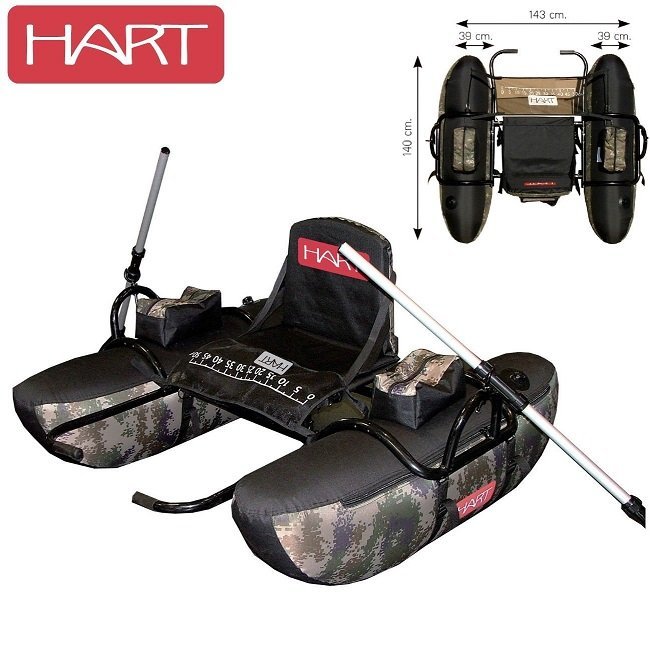
Advantages
- Secure water position,
- dry operation possible,
- stable basic construction and
- good expansion possibilities.
Disadvantages
- Relatively high purchase price,
- higher weight,
- elaborate structure,
- wind susceptibility,
- drive type without fins and
- less choice.
4. Is a wide range of accessories for belly boats recommended?
When buying a belly boat, it is almost always necessary to calculate the cost of additional accessories. The scope of delivery usually only includes an air pump and a transport bag. To be happy with the vehicle on the water, the basic equipment must therefore be supplemented with one or the other accessory.
Depending on the manufacturer and type of boat, the selected model at least already has zipper pockets and possibly also universal mounting options for rod holders or fish finders. Here you should know which belly boat accessories are desired in further consequence. This saves the search for suitable mounting options and OEM mounting aids afterwards.
The first question that arises on the Belly Boat is about the rods. Where to put them? In principle, there are three viable solutions.
The universal is a textile belt that is strapped around the hose. Attached to this is a piece of plastic tube to hold the rod. This simple and at the same time effective method is easy to implement yourself. The easiest way is to tie it and a piece of shrink tubing (possibly with glue), which additionally tightens the tube on the belt by heating.
It’s just as easy to get the sonar transducer in the water. To do this, use a tube-in-tube method with set screws to make the transducer adjustable in height. High for transport, lower for operation. Of course, you can also buy such belt solutions ready-made. It is much better, however, if the manufacturer supplies them as part of the design.
Rod holders can be mounted on universal mounting points on the belly boat, for example. Sonars also fit on such mounting islands. At best, these are already available or you can attach them yourself (e.g. using FASTen locks). Suitable accessories can be found from the same supplier.
The third solution is bracket tabs or tube mounts behind the seat back. This works quite well even with inflatable seats. All other utensils necessary for fishing, you stow in the usually supplied bags. There also fits the personal food ration.
Larger items such as the wading net and the box (insulated bag) for the caught fish belong behind the seat. This storage space is important. The area depends on the size of the belly boat, so you should not choose too small. Last but not least, a support surface (table) in front of the seat position is helpful in practice as a storage place. Usually it is a stretched net, which can be quickly attached and removed. This belly boat accessory belongs on the MUST list, if it is not already included.
Opinions are divided on the question of whether you need a fish finder for a belly boat – and if so, which one.
- Some consider it superfluous because fishing is only done in the shallows anyway.
- The others do not want to give up having information about the bottom of the water and the occurrence of fish.
In the end, it is always a question of cost. Who already calls a fish finder his own that is suitable for use on the belly boat, which should not abandon the use. For new purchases, the question arises:
- Which model,
- with which features and
- what screen size
may it be?
-

The Ultimate Fish Finder Guide
Download 40 pages for free now
Reviews ( 17 )
- Rated 5 out of 5
Raphaël G
Very effective. - Rated 5 out of 5
Vladimir M
The book describes the fish finder physics and builds up your understanding of how it actually works. I have yet to apply this knowledge with my Humminbird, but having that much of theory is extremely helpful in understanding and processing the sonar output. - Rated 5 out of 5
NICHOLAS JOHN REECY
The Deeper Guide was just what I was looking for. YouTube is full of reviews of the sonar but little in the way of education. I highly recommend for those wanting to better understand their Deeper sonar. - Rated 5 out of 5
Henrik
I am a beginner when it comes to fishing with fish finders. For me, the book has been very informative to judge the displays on the fish finder “realistically” and to recognize what limits there are when searching for fish with the fish finder. Now I know when I have to use my regular sonar and when I have to use my ClearVü or which settings I should apply to the device at which spot. I was impressed by the many illustrations, especially for understanding the functions. - Rated 5 out of 5
Dr. Manfred Marx
Very well written, so that it is understandable even for amateurs and structured concisely. - Rated 5 out of 5
Andreas Witz
An excellent book for learning about fish finders. - Rated 5 out of 5
AK
The ultimate fish finder guide is a beneficial introduction. I am excited to put into practice what I have learned. - Rated 5 out of 5
Lübbe Wolfgang
A well-written problem solver. - Rated 5 out of 5
Kalksee
The book is unmatched for understanding how a sonar/fish finder works. I was a fish arch hunter, and I suspect my fishing tactics will change. The book has clear writing, and you understand you understand a lot the first time you read it. I can only recommend it to anyone interested in technology. Thank you for this fantastic book! Thoralf - Rated 5 out of 5
Enrico Indelicato
I had absolutely no idea about fish finders. Since I read the book, I had a real Aha experience! For me, as a beginner, very detailed and uncomplicated explained. I can only recommend it! Best regards Enrico - Rated 5 out of 5
Udo
Reading this book has suddenly made my fish finders much more valuable to me! I realized that I made typical mistakes in interpreting the images, which I will now avoid. The authors use clear, understandable language and also explain the mathematical-physical basics very well. The fact that there is no advertising for one or another fish finder manufacturer has increased its credibility. At the same time, you get a solid impression of what is feasible today on this subject – and the “advertisements” of the manufacturers also helped. The book is ABSOLUTELY to recommend, because what good is an expensive fish finder if you too often draw the wrong conclusions from the obtained illustrations? In this respect, the money for the book is very well invested. - Rated 5 out of 5
Josef Weiss
I had to wait a long time for such great explanations. Thank you. - Rated 5 out of 5
Peter
It is a well-described, scientifically sound book highly recommended to anyone who wants to advance and doesn’t already know everything. - Rated 5 out of 5
Holger Just
Ich angle seit Jahren mit Echolot. Aber erstens bleibt man da irgendwann auf einer bestimmten Verständnisstufe stehen, diese konnte ich durch dieses Buch um einiges anheben. Als zweiten Aspekt mußte ich nach dem Lesen dieses Buches erkennen, dass ich durch “gefährliches Halbwissen” jahrelang Fehlinterpretationen hatte bzw. die Möglichkeiten meines Lotes nie richtig ausgenutzt habe. Also mein Fazit : Sehr empfehlenswert, die komplexen Zusammenhänge sind verständlich beschrieben. Das Buch ist ideal geeignet um sich in der angelfreien Zeit wertvolles Wissen für die folgende Saison anzueignen und beim Thema Echolot wieder uptodate zu sein. - Rated 5 out of 5
Matthias Wappler
Sehr gut!! - Rated 5 out of 5
M. Hermanns
Wer dieses Buch nicht liest, ist selber Schuld! Kein Vortrag, kein Presseartikel oder Bericht, Nein sogar keine Online-Schulung oder gar ein 365 Tage Support, vermittelt so viele essentielle Kenntnisse, wie dieses Buch. Nach zwei drei bebilderten Erklärungen wird dir klar, das ohne dieses Wissen, die Gewinn bringende Nutzung eines Echolotes gar nicht möglich ist. Beziehungsweise dir wird klar das du dein Echolot bisher sehr ineffizient genutzt hast und das dir eine Menge verborgen geblieben ist. Ich habe nach dem ersten gleich drei weitere Exemplare gekauft und drei guten Angelfreunden eine Anerkennung für unsere Freundschaft mit diesem Buch gemacht. Alle drei verfügen über 30 Jahre Bootsangelerfahrung und alle drei waren ebenfalls begeistert, jeder konnte sein Wissen deutlich erweitern. Deshalb freue ich mich auch so sehr auf das Zanderbuch welches hoffentlich noch vor dem Wochenende bei mir ist. Liebe Grüße weiter so. dermarc - Rated 5 out of 5
TACKLEFEVER
Das Buch beginnt mit rund 15 Seiten Technik Erläuterung bei der versierte Echolot Nutzer, zu denen ich mich zähle, vielleicht geneigt sind weiter zu blättern weil sie vieles schon wissen und Anfänger weiter blättern möchten weil es zu trocken scheint. Aber etwas Basiswissen gehört einfach dazu. Selbst wenn man als Anfänger bei der Basis Theorie weiter blättern will, sobald es um Chirp geht sollte “jeder” genauer hinschauen 😉 es lohnt sich. Und auch für mich fand ich noch ein zwei kleine Dinge die ich nicht wusste oder noch nicht im Zusammenhang mit anderem sah. Die weiteren Abschnitte (bis Kap. 3) befassen sich mit den verschiedenen Techniken der Geber, Bildschirme, oder dem Smartphone, dem Tablet als Anzeigemedium. Was mir bis dahin sehr positiv auffiel waren die “MERKE-Boxen”, kleine übersichtliche Passagen welche Kerninformationen des zuvor vermittelten Wissen zusammenfassend hervorheben. Auch wenn man nicht alles komplett verstanden hat, hilft diese leicht verständliche Zusammenfassung des voraus gegangenen Inhalts sehr. Kapitel 4 geht auf 2D, Down-Imaging, Side-Scan-Sonar ein, dabei ohne zu konkret auf einen Hersteller abzustellen was ich ebenfalls sehr positiv fand. Dem Angler wird der praktische Einsatz und das Verstehen dessen was man auf dem Echolot sieht erläutert. Fragen wie z.B.: Wo befindet sich der Fisch genau? Was ist eine Fischsichel? Wie setze ich das Echolot beim Vertikalangeln ein? Warum gibt es Vertiefungen obwohl man keine sieht und umgekehrt? Wie erkenne ich die Bodenbeschaffenheit? Fragen zur richtigen Deutung der Unterwasserstruktur, dem optimalen Bildlauf- und Boots- Geschwindigkeit, der Sprungschicht, usw. werden auch beantwortet. Würde ich alles aufzählen würde es hier zu weit führen. Es folgen noch kurze Infos zur Multibeam Technik und ein Kapitel “Die 3D Show mit Garmins Panoptix”. Hier wurde für mich zu wenig Wissen vermittelt, nur auf einen Herstellers gezeigt und nicht auf ähnliche Funktionen oder Techniken anderer Hersteller Bezug genommen. Ich hoffe es kommt in der nächsten Auflage mehr zu dem Thema. Am Ende des Buches kommen Infos rund um konkrete Einstellungen am Echolot. Hier wird einer der wichtigsten Punkte überhaupt behandelt und dies praxisnah und hilfreich. Aller spätestens jetzt lohnt sich das Buch für alle Neueinsteiger. Viel einfacher und kompakter geht es kaum. Ein paar wichtige zuvor besprochene Punkte zu Einstellungen bei bestimmten Echolot Funktionen werden erläutert und mit Checklisten im Kapitel “Die effektivsten Einstellungen beim Echolot auf einen Blick” zusammen gefasst. Hier lohnt es sich für Anfänger die Seiten besonders aufmerksam zu lesen und vielleicht als Kopie mit auf Boot zu nehmen. Damit fällt der Kampf mit den gefühlten tausenden von Einstellungen am Echolot auf dem Wasser leichter. Es klingt fast zu schön um wahr zu sein, aber tatsächlich scheint mir das Buch für Anfänger und Fortgeschrittene Anwender gleichermaßen gut geeignet zu sein. Manchmal suchte ich mehr Hintergrundwissen, weil der im Prinzip sehr gute Ansatz es für Anfänger leicht verständlich zu halten manche Herstellerabhängige Feinheiten außer Acht lässt. Das Buch hat eine gute Gliederung, fasst vieles kompakt zusammen und geht bei wichtigen Punkten auch meist für Fortgeschrittene etwas in die Tiefe. So richtet sich das Buch meiner Meinung nach nicht an wissenschaftliche Anwender, sondern an Echolot Neulinge indem es auch viele Basis Fragen beantwortet ebenso auch an Fortgeschrittene indem es auf diverse Punkte tiefer eingeht. Wenn ich den Sinn des Buches in einem Satz beschreiben sollte, dann wäre dies: Echolottechnik für Anfänger interessant und verständlich erklären und dabei auch ein wenig tieferes Wissen für alle zu vermitteln. Mir ist Stand Juni 2017 kein anderes Buch bekannt das diesen Ansatz so konsequent verfolgt. Ich hoffe ihr habt so viel Spaß beim lesen wie ich. Luke www.tacklefever.de
5. Which fish finder for the belly boat?
Let’s first discuss the screen size. Some belly boat users swear by 4-inch devices because they are so beautifully small, handy, light and unobtrusive. The fishing depth is displayed quite reliably on these devices. All other information up to the fish echoes should be sufficiently informative for the usual water depths up to approx. 20 m. In addition, there is the price. Such devices are, depending on the equipment, with transmitter somewhere between one and two hundred euros.
Other users refer to the usual 6-inch size of their smartphone and consider a 5-inch device to be the suitable solution. With a 5-inch device, you are definitely right at home on the Belly Boat. Compared to the 4-inch models, the screen is significantly larger, has a better resolution and thus displays more details. The technical screen quality with anti-reflective coating, brightness and contrast reproduction as well as viewing angle stability also speaks for this size. Likewise, the higher transmission power of the device, which ensures better fish finder images even in shallow water.
And last but not least, those who want to use the mapping capabilities of their device should leave the 4-inch models out. If you have ambitions to use a SideScan mode, you will only find one in the 5-inch range (or higher) anyway. Larger screens than 5 inches are possible for the Belly Boat – but not always recommended. Unless you already own one. However, one must be aware that the large housing can limit the radius of action on the boat. Also, the power consumption requires larger sonar sounder batteries and all together means additional weight.
One thing should not be forgotten when using the sonar on the belly boat. At shallow water depths, the area that the sonar signal can cover is sometimes small. All the more important in these water regions is a large opening angle of the transducer, which can scan the shallow area more comprehensively.
An example: The Garmin Gt20 transducer has an aperture angle of 45° at 200 Khz. At a water depth of three meters, this means a circular coverage with a diameter of 2.5 m; at 6 m, this would be around 5 m. A Humminbird Dual Beam Si transducer with 74° aperture at 3 m water depth provides a coverage area of 5 m in diameter, at 6 m depth it would already be 9 m
Here you will learn everything about “How do fish finders work and how do you use them“.
In the end, everyone has to decide for themselves which device is best suited for whom. However, it is true that more information is useful for this purpose. We have selected three devices from inexpensive to expensive in four and five inch design, which make sense for a possible use on the Belly Boat.
5.1 Recommended 4-inch device: Garmin Striker Plus 4cv, GT20 transducer
With 300 W system power and modern sonar technology, the Striker Plus 4cv is technically well equipped. This Garmin fish finder not only makes use of the modern chirp sonar, it also supplies the good Gt20 dual beam transducer, which can chirp in dual frequency mode (77 / 200 Khz) with 20 Khz frequency width. The images are well structured and detailed in the display.
In this price range, you can be satisfied with the scan results even in downscan mode. With Garmin Quick Draw Contours, the device also has the option to create your own depth maps of your personal favorite waters. A GPS module is built in and allows all basic functions to find successful fishing spots.
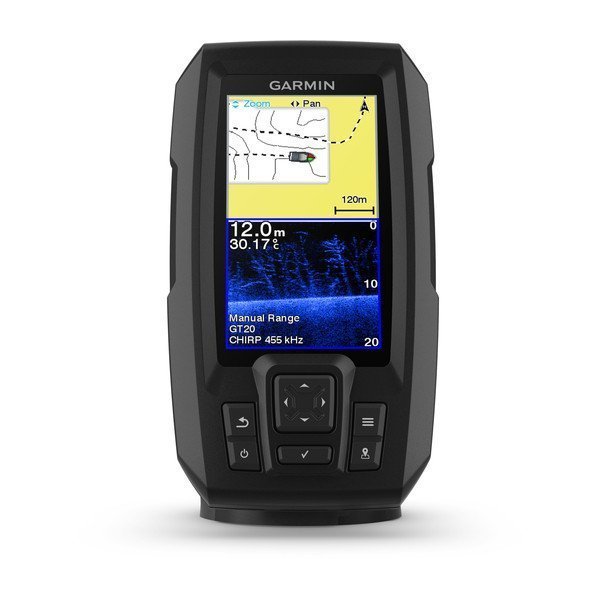
Main features
- GPS fish finder with 4.3-inch display, industry-leading fish finder and Quickdraw contours mapping software.
- Includes transducer for integrated traditional CHIRP, as well as CHIRP-ClearVü.
- Integrated Garmin Quickdraw contours map software to create and save maps with depth contours of 1 foot (30 cm) for up to 2 million acres (8000 km²).
- Integrated GPS for marking waypoints, creating routes and displaying the speed of the boat.
- Bright 4.3-inch display, easy to read even in sunlight, and intuitive user interface.
- Robust design suitable for all fishing conditions.
- Price: about 200,00 €
5.2 Good choice for the 5-incher: Lowrance Hook 5 Reveal with HDI transducer
In the third Hook generation, the devices and HDI transducers have been fundamentally revised. As a result, we now have Chirp in parallel with DownScan and the Reveal function as a special treat. In the Reveal process, the fish arches from 2D are fitted into the DownScan image as illuminated arcs, so that an optimal representation of the detected fish population is directly available.
This Lowrance fish finder makes adjustments and fine tuning automatically. No manual adjustment is needed to get the best images, so it’s perfect for belly boats. Finding fish can be so easy with the right sonar.
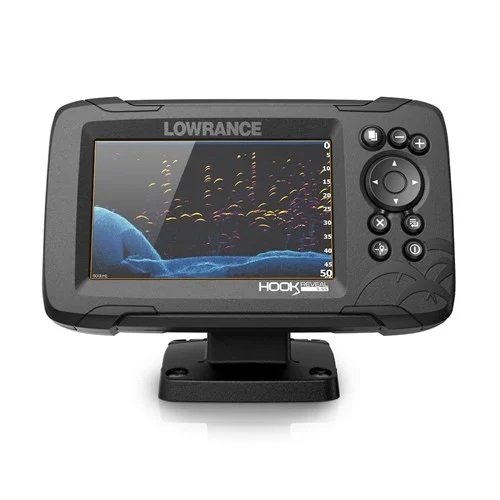
Main functions:
- FishReveal,
- Genesis Live Real-Time Mapping,
- automatic fine tuning,
- 83 / 200 HDI transducer with CHIRP and DownScan,
- SolarMAX display with 800×480 pixels,
- Transmitting power 500 W,
- Keypad operation with access,
- microSD card slot and
- GPS with chart plotter.
- Also, mapping options such as C-MAP, C-MAP Genesis or Navionics.
- Price: about 320,00 €
5.3 The Belly Boat Highlight: Humminbird Helix 5 SI CHIRP GPS with G2 transducer (model year 2020 with Si transducer)
In the 5-inch range, this Humminbird fish finder is an absolute highlight on the belly boat – not only for friends of pelagic and vertical fishing. With real chirp in all three fish finder modes (2D, Down- and SideScan), the autochart live mapping system as well as a simplified operation (reflex menu), the extremely differentiated, detail-resolved images convince all along the line. Humminbird has done a good job here, both in terms of equipment and technology. With the SideScan function, guessing where the fish is currently located on the Belly Boat is no longer an issue.
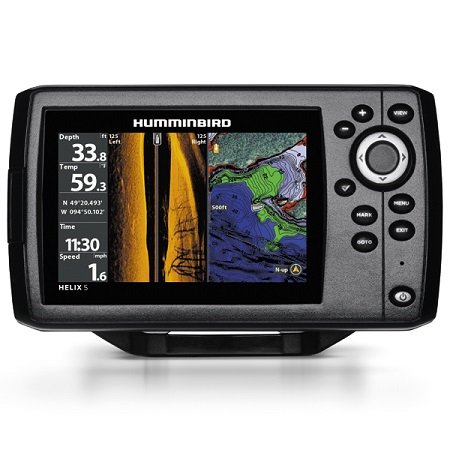
Some highlights of the fish finder:
- True chirp and switchfire in 2D, down and side image.
- 3-frequency transducer SI with 2 x 85° transmit cone, 455 kHz @ -10dB and 20° & 60°-
Transmit Cone, 200 & 83 kHz @ -10dB (Side Imaging 180° coverage, Dual
Beam PLUS™ with SwitchFire and Down Imaging). - Autochart Live creates depth maps in real time.
- Jigging mode for vertical and pelagic fishing.
- Screen 800 x 480 pixels with 256 colors in 16:9 format.
- Transmitting power 500 watts.
- Reflex interface for intuitive and easy operation.
- Various setting options, e.g. for the transmission frequencies or transducer angles.
- SD card slot.
- Chart plotter function with common nautical charts.
- Precise GPS with high sensitivity.
- Humminbird Unimap Sea Chart Europe pre-installed.
- Price with SI transducer: about 465,00 €
6. Buy a belly boat: Our recommendations
When selling fish finders, many dealers experience that customers exceed their price range, sometimes considerably. The reason: The customer wants to buy the latest technology. Whether he needs it, is rather not questioned. Well, an overqualified fish finder does no harm. In the end, one has only spent too much money.
With the belly boat, the conditions look quite different. Our safety on the water depends on this vehicle. So every decision for or against a certain model always has to do with the question of how much my own well-being is worth to me. Anyone who has internalized this when buying such a vessel will look very carefully at what is offered to him. In case of doubt, you will also have to question your budget limits. Here, however, under a different premise than when buying a fish finder.
We now want to talk through the quality features and equipment details that should be important as purchase criteria on a single Belly Boat. In our opinion, the model Elling Optimus Max presented here is well thought out in every detail and of high quality. The manufacturer is located in Ukraine (made in EU), the boat is distributed by Boat-Expert in Hanau, who is also involved in the development.
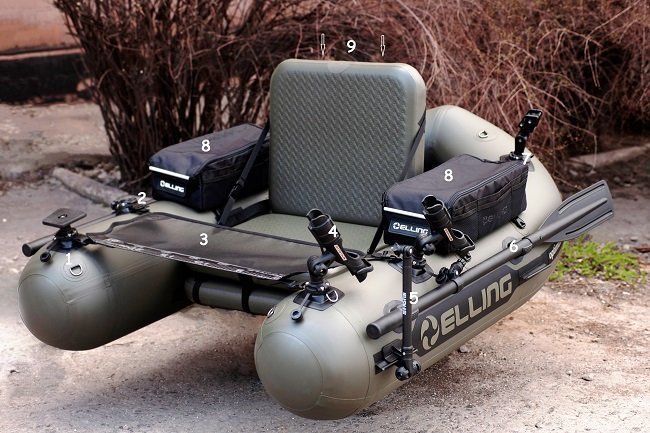
The vehicle is made of 5-layer PVC, which brings a mass of 950 g / m². All main seams are welded. This is important for durability and tightness reasons and is not standard for a long time for most representatives of the genre, which mainly come from Chinese factories.
With a hose diameter of 32 cm and a length of about 170 cm are more than 250 kg load capacity on offer. 55 cm seat width ensure freedom of movement when fishing even for stronger sports enthusiasts. Buoyancy reserves are available even when fully equipped with equipment and choppy weather enough. With three separate air chambers in the hose, the compressed air seat and insert floor, there are a total of five separate air-filled units that ensure a high safety standard.
Five usable mounting islands with FASTen universal locks on the hoses, two mounting rails (lieks) each on the left and right side of the hoses and two slide-in holders (plastic loops) on the seat back make the Optimus Max suitable for the vast majority of equipment wishes out of the box. Rod storage no problem, either in the plastic loops at the back of the seat or / and in two supplied FASTen rod holders that are clicked into the locks.
A FASTen mounting platform is provided for the fish finder and the also supplied articulated rod for the transducer is pushed into one of the mounting rails (Leaks). Preferably in the rear area, so that the water flow does not interfere with the echo during fin movement. FASTen-Borika oars made of coated aluminum with patented FASTen oarlocks form the second drive concept of the Optimus Max. The oars also fit into the rod holders on the seat, in case the rack on the side tubes should interfere.
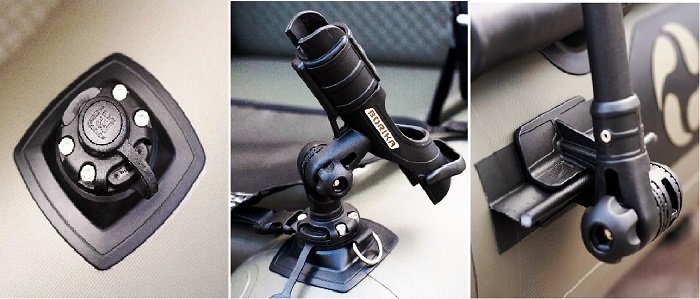
Another PLUS are the removable bags with 27 liters volume each. This provides enough storage space even for extensive accessories. The workmanship, the quality of the zippers and the strap material used for fastening are designed for continuous use. Finally, the scope of delivery also includes an adjustable FASTen anchor clamp and eight mounted stainless steel D-rings. They are distributed around the boat in key locations. An electric motor option is also available.
A suitable engine mirror can be retrofitted at any time. There are two types of mirrors to choose from: One for the pointed bow, and another for side mounting. Accessories such as a telescopic rod for the Lonako position light and the towing pennant, additional FASTen holders, rod holders or articulated rods for the action camera can also be retrofitted if required. Overall, many details are right with this boat, because they were first thought practical and then consistently executed in high quality.
So how can you proceed if you want to buy a belly boat? First, we put all the features of this boat in a table, in which you can enter in parallel the boat or boats that you have in mind for purchase. In a direct comparison, one will then compare one’s choice with the optimized boat shown here, calculate the accessories and calculate the final price. After that, it is easy to estimate what you get for your money and how practical it is.
Criteria for buying a belly boat:
| Elling Optimus Max www.Boat-Expert.de Price : 845,00€ | Equipment Execution Equipment | Extra costs | Name | Equipment Execution Equipment | Extra costs |
|---|---|---|---|---|---|
| Material usage | PVC 950 g/m² | ||||
| Seams | welded | ||||
| Air chambers base | three | ||||
| Total air chambers | five | ||||
| Load capacity | > 250 kg | ||||
| Weight | 15.5 kg | ||||
| Pump and repair kit | Yes | ||||
| Aluminum rudder | two | ||||
| Pockets | 2 x 27 l | ||||
| Pockets removable | Yes | ||||
| Seat above water | Yes | ||||
| Ground plane solid | Yes | ||||
| Floor support air filled | Yes | ||||
| Seat air filled | Yes | ||||
| Tensioning net rear | Yes | ||||
| Mounting rails Leaks | four | ||||
| FASTen universal lock | five | ||||
| D-rings stainless steel | eight | ||||
| FASTen rod holder | two | ||||
| FASTen sounder platform | one | ||||
| FASTen tilt rod for the transducer | one | ||||
| FASTen anchor leash clamp | one | ||||
| Engine mirror | Available as accessories | ||||
| Additional FASTen accessories available, e.g. for GoPro | Yes | ||||
| Total price | 845 € |
7. How to fish with the belly boat?
Let’s go in order. The Belly Boat itself fits into a large sports bag – or, depending on the packing format, into a cuboid packing format. In terms of luggage space, any medium-sized and not too shallow luggage compartment of a car is suitable for transport. However, if you want to go on vacation with the whole family, you should have a large van, because a mid-size station wagon can be a bit cramped. In terms of weight, we are in the range of less than 20 kg. So it can still be carried well alone. Often the transport bag can also be packed with straps on the back. Ready-built boats sometimes also have this option.
The boat assembly with all accessories takes about 20 minutes. With a lot of routine it also goes faster. The volume of the air pump of course has an influence on the time. In a jiffy it goes electrically, but then the car must be handy or the fish finder battery is in use. With electrically operated pumps, a pressure limit should be adjustable. No one wants overstretched seams or hoses because they were not inflated carefully. As an insider tip are considered battery-powered air pumps, which are very handy and have pressure limits. These are great for inflating a belly boat and are also recommended for emergencies on the water. The cost of one is manageable at around €40.
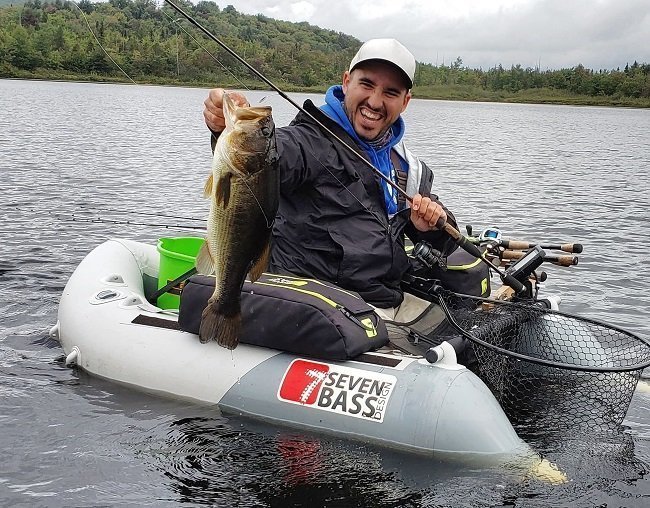
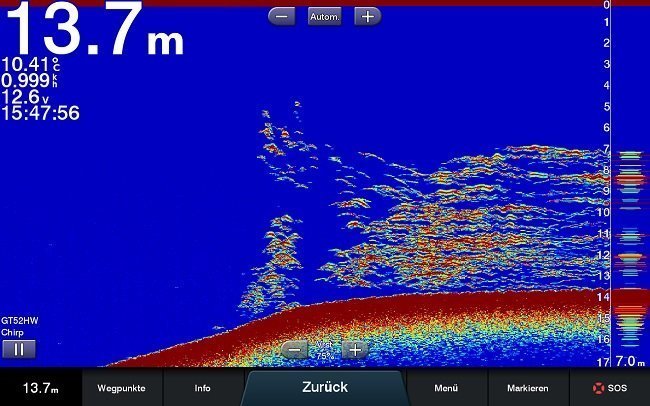
When entering the water, there must be enough water under the boat to avoid damage. With a boat on the bottom nothing goes forward anyway. Walking with fins is a little unusual. But the movement with the flotation devices in the water to move forward is mastered intuitively.
For rods, small types around 2 m in length are advisable. A short handle length is also an advantage. Anything else is unwieldy and spoils the pleasure of fishing quickly and permanently. Special care is required with the hooks. Horror scenarios such as “hook slips out with big fish close to the boat” could lead to the realization that “the air goes out!
What takes some getting used to is the feeling of sitting a bit on the turntable. When drilling a larger fish, this is rather advantageous, because the change of direction of the fish can be followed quickly. Due to the small boat dimensions, there is also no problem if the fish pulls under the boat. The landing net is on board in the wading version. You sit directly at the fish to be landed. On the belly boat no one knows anyway where to put long handles when the fish changes sides.
Here, order fanatics are clearly at an advantage. There is little room to look for anything. Pointed objects are enemies of the floating base and it is difficult to sit on hooks anyway.
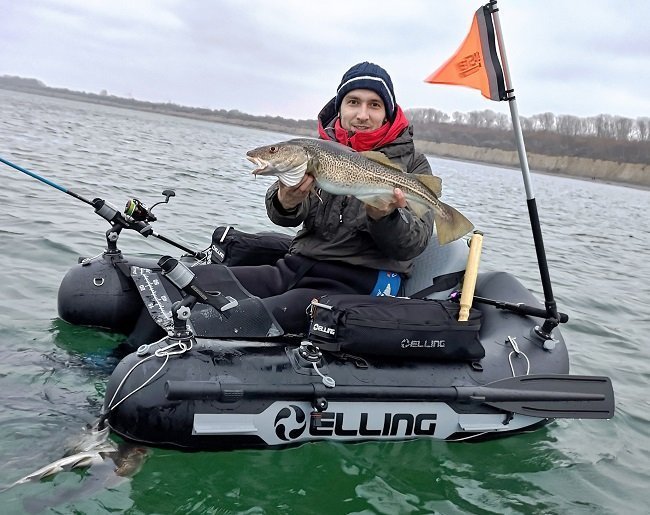
As soon as the longed-for fish is hooked, the question arises: “Where to put it? On the boat it can sometimes get quite warm – thank PVC. The only thing that helps is the expert method: pull the fish onto a string and leave it in the water to cool it down. That’s what the Native Americans did when they went canoeing on the great lakes.
What knowledge remains? When deciding to buy a belly boat, you should take your time to carefully weigh all the criteria. Fishing with such a boat is a lot of fun and justifies the effort. It feels like you are closer to the action on the rubber tire. With the right evening mood or early morning fog, you literally melt into the elements. This may well be due to the fact that part of the body is permanently submerged.
8. Safety: top priority for the Belly Boat?
Of course, no one will disagree – even if the reality is often different. Let’s be clear: our lives depend on a piece of inflated hose that will surely sink with even minor leaks. The question arises, who has already made swimming attempts with clothes and waders? The answer no one wants to know.
The important thing is: everyone must be aware of the risk of belly boat use. Especially if he is on the move on larger waters. Appropriate safety equipment should always be on board in case of emergency. Experts also recommend wearing a life jacket at all times. Otherwise, carrying an air pump, signal whistle and a waterproof packed cell phone can actually only be useful. And if you’re traveling with a partner, you’re well protected against all eventualities.
-
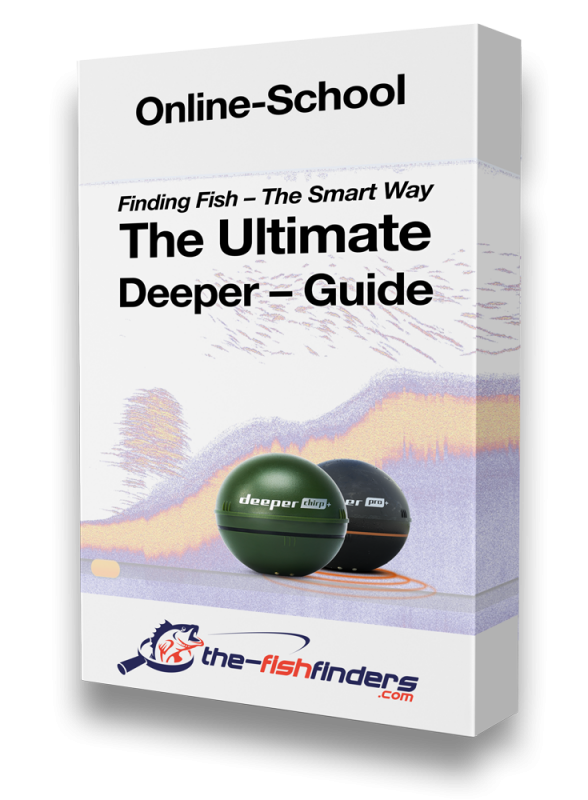
The Ultimate Deeper Guide
Read more
Reviews ( 88 )
- Rated 5 out of 5
1
555 - Rated 5 out of 5
David Murray
Still going through the course but learning new things all the time. Been fishing for a long time never thought I would ever use a piece of fishing kit like this but wish I had been able to use it a long time ago. Early days but keep going back to the course to refresh my understanding of the finder very glad a made the purchase both deeper and course - Rated 5 out of 5
Johan
The deeper training was super, i learned a lot from it. It brings my skills to an higher level. Thanks for that. Regards Johan - Rated 5 out of 5
Maarek Jõhve
The online course provides excellent insight into better use of deeper sonar. The course chapters are of appropriate length and in good order. I have a Deeper Chirp +2 myself, so the best hands-on tutorial for me was how to use different beam angles and frequencies. I liked the part about using the Lakebook the most. Thanks to this section, I discovered for myself how exciting it is to look back at the water bodies I visited during the past year on the computer and examine in detail the sonar recordings made then. With the new knowledge I learned in the course, I started looking at sonar recordings with a completely different eye. Now I know a lot more about how fish behave and how to find new hot spots. I recommend this educational and very comprehensive online course to all Deeper users as well as regular anglers. - Rated 5 out of 5
Ap
Ordering the course was a gamble for me as I am not a fisherman. Together with my son we are busy doing all kinds of things underwater with a professional underwater drone and finding things for others. A “Deeper” seemed useful to us for locating and making the depth map. Well, I don’t regret taking the course, because it contains a lot of useful information for me too. For example, finding the thermocline, shipwrecks, structure, and other hot spots. And of course the proper operation of the Deeper itself. Highly recommended. - Rated 5 out of 5
Robert
Very well organized and presented; I will be ready whenever / if ever?? my Chirp+2 gets to U.S. f/ UK 🙂 - Rated 5 out of 5
fishermanfromtown
Very good course especially for beginners. All the topics arranged in well organized contents which you just have to follow from A to Z. Technical informations explained in very easy to understand terms. I am recommeding to everyone who wish to learn Deeper Sonar and its capabilities. Martin
Hi Nicolas, Pas encore, j’en ai peur. Nous commençons tout juste à parler anglais. Les sous-titres anglais sont en cours d’élaboration en ce moment même. Cela aiderait-il ? Une question de notre part : Seriez-vous intéressé par le cours en anglais mais avec des sous-titres français ? Vos commentaires nous aideraient à déterminer comment nous nous alignerons à l’avenir. Martin- Rated 5 out of 5
Nicolas
Bonjour, Est ce que cette formation DEEPER est disponible en français ? Martin
Hi Lars, Thank you very much for your feedback. In the next year, we will steadily expand the course to include such outdoor recordings. They will be available for all current users, allowing you to continuously improve your handling of the Deeper. Greetings and tight lines Martin- Rated 4 out of 5
Lars Dahm
The course was insightful, maybe a little too much theory portion. I would have preferred more practical “lessons” on the water. As theory and practice differ from each other, an instructional video on the water (how to find hotspot with a wide cone, and predators with a broad, medium, and narrow cone, how to cast to and catch fish) would have been useful. - Rated 5 out of 5
Christoph Fink-Kneer
One of the best online courses I have taken. Easily accessible, even for beginners, and the different subdivisions of the individual topics are also very well chosen. 5 stars. Keep it up!!!!! - Rated 5 out of 5
Axel
I have a Deeper Pro+ and hope that I will have more fishing success in the future. The lessons in this course are explained articulately, even for beginners like me. I will now try to put the theory into practice. I consider the lessons concerning the chirp, pike, and pikeperch as informative since I have “only” the Deeper Pro+ on the one hand, and on the other hand, the trout is my target fish. I will refer back to the course one or the other time to become even more confident using the fish finder. Thank you for this course. Martin
A carp part will follow as soon as we finish writing the book. Greetings Martin- Rated 5 out of 5
Mario Kastner
I think the course is very informative and gives a quick overview of the functions and how to use them. Suggestions for improvement: – Label more clearly what is relevant for Pro / Chirp users. – In addition to pike and pikeperch also deal with carp fishing. Otherwise, the course is excellent and highly recommended! Jens
Hi KB, thanks for your comment! We’re happy about your success, and we’re grateful for your tips. We’re trying to implement some of them. However, we are most interested in what you wanted to say with your last sentence. What would be this other possibility? Best regards, Jens- Rated 5 out of 5
KB
Thanks for the well structured and accessible format! I’ve had a few opportunities now to use the Deeper Chirp + while kayaking. This is where the basics (width of the cone, field of view, leveling d. substrate) have actively come back to mind from the webinar. Especially when scanning steeply sloping edges, that is, small plateaus that could only be found with the high-frequency cone of 7° and rewarded you directly with large perch. In part, you could link the other books more strongly when quoted or perhaps provide an excerpt. If another chapter on the further development of the app materializes, I’m looking forward to it! Another possibility would be to create a - Rated 5 out of 5
kovalex
A lot of work went into the creation of this course! Awesome! Thank you! Even though I lost my Deeper Chirp Plus on the Rhine a week ago, I am going to buy a new one! - Rated 5 out of 5
apexq
This is my second fish finder ever. My first was a cordless Humminbird RF1, which was not useful at all. The Deeper Chirp + is far and away superior to it. My first trial took place shortly after purchase but without knowing how to read it correctly. As a result, I was unable to see any fish and got quite frustrated. The course has shown me that I have set and interpreted the fish finder completely wrong. After some adjustments, I was able to see fish, and thanks to the videos, I can now read the bottom structure. This has been implemented perfectly in these training videos and is very easy to understand even for beginners. What good is the best fish finder if you can not interpret the signals? The training video is definitely worth the money. Again, thank you so much !!! - Rated 5 out of 5
Torsten
This course is extremely helpful, especially for beginners. It introduces the functionality of a fish finder in a way that is easy to understand and saves you from having to do a lot of research on the Internet. I am thrilled and will continue to follow your content on the net. - Rated 5 out of 5
Markus Daehn
I have been using a fish finder on my boat for many years. I never quite figured out the display and function. I watched numerous Youtube videos and learned a few things, but I was still far from being able to properly evaluate the information and put it to use. By purchasing the Deeper Chirp +, I came across this online course and can now say that I have taken away quite a lot not only for the use of the Deeper but also for modern fish finders in general. I can recommend this course to those who felt the same way as I did. I was familiar with some aspects, but many things were new to me and now help me in the use of my Deeper and even in the use of my Raymarine. Greetings Markus from Oldenburg - Rated 5 out of 5
Wolfgang Lange
Hi Martin, I happened to discover the site of fischfindertest, the Deeper, and the online course and was so excited that I booked the webinar right away. Until now, I did not know the structure, function, and operation of a fish finder. I enjoyed this beautifully structured Deeper course with all its lessons. What stood out to me was the comparison between the three transmission cones (Deeper Chirp) concerning the depth and diameter to locate fish accurately. Thank you, Martin and the entire team of fish finder test. Since no bathymetric chart exists for my home waters, a drinking water dam, I will buy the Deeper Chirp+. I like the fact that the Deeper can also be used in the boat and kayak without buying a very expensive fish finder. Maybe the use of a tablet is better than a smartphone. Regards Wolfgang from Schwarzenberg - Rated 5 out of 5
peter.schaup
Insightful course. I never knew which setting to use when and how. I will soon also test this when fishing and hope to catch more fish 🙂 Martin
Thank you for your input. We will add the download within the next week. Regarding the app, we are planning something. Currently, there are two apps available. We are waiting to see which app Deeper wants to continue to work with. Many thanks Martin- Rated 5 out of 5
Roger Hoffmann
Nothing but praise for the very informative webinar, thumbs up !!! You could add “indicator arrows” to the wreck chapter. In the 3D side scan, the ship was/is visible. I had quite a bit of trouble with the “normal” transmission cone views. I still have two questions: in chapter 4.2. you mention a download for the overview of the transmission cones. Unfortunately, I can’t find it. Have I possibly overlooked something somewhere? And will there be a “follow-up” in terms of a new “Deeper App”? - Rated 4 out of 5
Stefan Franke
Excellent course for a fair price. You learn everything necessary and can start well with the Deeper. There were times when the content was a little too focused on predators, but that’s okay. Top! - Rated 5 out of 5
Markus Marek
Great job! - Rated 5 out of 5
Mario
Very accessible and well explained. You delivered a lot of instructive information in a very efficient manner without wasting a lot of time. Thank you, this was awesome. - Rated 5 out of 5
Jan Gewald
Very informative course. Finally, I know how to use my fish finders correctly and what I can do with the displayed data. A must for every fish finder owner. - Rated 5 out of 5
Daniel Gerstberger
An excellent online seminar that is definitely worth the money. Everything about the functions of the Deeper Smart is covered. There is even an extra chapter on the chirp model. In my opinion, this course is a must for every fish finder and Deeper user, as it is really helpful. Everything from edges to find underwater wrecks is covered. Simply great Thanks a lot - Rated 5 out of 5
Jens Rösler
I can only recommend this course. It not only teaches the basics of the Deeper wisely but also makes you hungry for more. Thank you, and keep up the good work! - Rated 5 out of 5
Michael
A very appealing and well-edited course. Since, as of recently, I can call a Chirp+ my own, the course has helped me very well to first understand the conversion of sounds to images, and then also to be able to read/interpret them! Perfect! I can recommend the course without reservation and would buy it again 🙂 - Rated 5 out of 5
Juergen Wartmann
Since I have already worked with fish finders on the boat, I initially thought I do not need such a course. However, I was still curious and booked it. Today I can say that I have never really operated a fish finder the right way until now. I am so glad that I took part in the training as I gained insight into many aspects. I have a Deeper Chirp + and only booked this course because it is also covered – and that, as it turned out, in great detail. I can recommend this course without hesitation. - Rated 4 out of 5
Christian
The course offers a well-balanced mix between theoretical basics and practical advice. I have explored my fishing spot and was surprised. The Deeper will always be with me from now on. - Rated 5 out of 5
Schreiegg Georg
Ohne diesen Online- Angelkurs hätte ich nicht soviel wissen über die verschidenen Deeper in so kurzer Zeit erhalten, einfach klasse und gut erklärt. - Rated 5 out of 5
Christopher Neumann
Einfach nur Top! Als Echolotanfänger hat man es schwer die Bilder auf dem Bildschirm richtig zu interpretieren aber jetzt fällt es mir nicht mehr so schwer strukturen zu erkennen und richtig zu deuten! Jetzt kann ich mit dem Deeper Chirp richtig los legen und Hotspots finden! Danke dafür 😉 - Rated 5 out of 5
Markus Kaiser
Ich bin absoluter Echolot Neuling. Als solcher hätte ich tatsächlich eine falsche Vorstellung davon, wie die Anzeige genau zu deuten ist. Ein sehr komplexes Thema verständlich erklärt. Ein paar Dokumente zum Ausdrucken wären noch wünschenswert. Die wichtigsten Einstellungen, eine Tabelle der unterschiedlichen Scanwinkel mit Tiefe und Fläche und sonstige Merkpunkte halt. Alles in allem kann ich den Kurs aber uneingeschränkt empfehlen. - Rated 5 out of 5
Benjamin Völker
Super Videos und von Anfang bis Ende erklärt. Bin Echolot Anfänger und habe das mit dem Sendekegel endlich verstanden ☺️. Sowie dass auch eine halbe oder nur Ansatzweise eine Sichel ein Fisch sein könnte ?. Kann ich nur empfehlen ? - Rated 5 out of 5
Martin Hunsicker-Wilhelm
Nur mit lesen im Handbuch bin ich verzweifelt. Schön, dass ihr so viel Arbeit reingesteckt habt. Absolut sein Geld wert! - Rated 5 out of 5
Alexander Knodel
Sehr hilfreich…. alles gut erklärt - Rated 4 out of 5
Olaf
Hallo, als absoluter Neuling im Bereich des Angelns mit Sonar haben wir uns einen Deeper CHIRP+ zugelegt und dann auch versucht uns online “schlau” zu machen. Relativ schnell sind wir dann auf über den Kurs “gestolpert”. Mit wenigen und einfachen Videos wird hier die Funktion gut und schnell erklärt. Besonders gut fanden wir die grundsätzlichen Erklärungen zur Funktion der Technik. Unsere ersten Versuche führten zwar noch nicht zum Fangerfolg aber im Umgang mit der Funktion sind wir erheblich weiter gekommen. In der nächsten Woche werden wir das Gerät und unser Wissen am Meer und in Flüssen und Seen weiter testen. - Rated 5 out of 5
Klaus Gampp
Wer zuvor noch nie oder wenig mit einem Echolot gearbeitet hat, wird eine vorbildliche Einführung erhalten. Dann macht es auch Spaß das Teil am Gewässer einzusetzen. Super Sache. Macht weiter so. - Rated 5 out of 5
Cedric Engler
Vielen Dank erstmal an das Team für den Kurs ! Hat mir sehr geholfen für das Verständnis des deepers und der verschiedenen Einstellungen. So verbringt man mehr zeit zum suchen der Fische, und verschwendet die Zeit am Wasser nicht zum verstehen und testen. Einfach genial ! - Rated 5 out of 5
Lukas
Sehr zu empfehlen. Auch und ganz besonders für Echolotneulinge, welche sich ein solches Gerät zulegen möchten. Habe den Kurs jetzt bereits zwei mal komplett geschaut und aufgearbeit und bin hellauf vom Umfang und dem vermittelten Wissen begeistert. Ohne ihn hätte ich mit deeper tatsächlich recht wenig anfangen können. Dieser Kurs gehört daher zur Pflichtlektüre und sollte eigentlich bereits beim Gerätekauf enthalten sein! ? Von mir eine uneingeschränkte Empfehlung - Rated 5 out of 5
Sergej Meder
Ja richtig viel gebracht das Video es ist sehr informativ und ich werde jeden weiter empfehlen. jeder Euro ist wert .-) - Rated 5 out of 5
Oliver A.
Hallo Fischfinderteam, danke für diesen sehr informativen Kurs. Ich habe keine Erfahrung mit Echoloten. Nach den ersten zwei Einsätzen meines Deeper war ich nicht ganz zufrieden mit dem Ergebnis. Ich hatte sogar den Verdacht er würde nicht richtig funktionieren. Ich habe in dem Kurs sehr viel gelernt was mir hilft die Bilder besser zu Interpretieren und bei der nachträglichen Auswertung der ersten Aufzeichnungen im Lakebook sind mir dann Dinge aufgefallen die ich vorher gar nicht beachtet haben. Der Kurs ist sehr gut aufgebaut und wird für Laien verständlich erklärt. Das Zuschauen hat Spaß gemacht und ich freue mich das gelernte Wissen am Wasser umzusetzen. Martin
Hallo Gerrit, vielen Dank für deine Anmerkungen. Wir werden die Live Verwendung des Deepers am Wasser mal auf unseren to do Zettel nehmen. VG Martin- Rated 4 out of 5
Gerrit Mosig
Der Kurs hat mir gut geholfen den Deeper Chirp und dessen Funktionsweise zu verstehen. Sehr lobenswert ist das kurze Kapitel zum sicheren Befestigen und der Tipp mit dem Zettel! Insgesamt finde ich die Präsentation etwas trocken und schlicht. Da wünsche ich mir etwas mehr Interaktion und eventuell mal kurze Videomitschnitte aus der Live-Anwendung. Dennoch wurde der Inhalt verständlich vermittelt, auch wenn es interessanter hätte gestaltet werden können. Vielleicht helfen dem Einen oder Anderen noch ein kurzes Quiz am Ende eines jeden Kapitels?! Grundsätzlich wünsche ich mir noch Tips zur Benutzung des Deepers mit den jeweiligen Möglichkeiten. Also zum Beispiel: wie gehe ich konkret vor wenn ich das erste mal am neuen Gewässer bin und den Deeper vom Ufer aus benutze. - Rated 4 out of 5
Julian Koehler
Moin, ich fand des Kurs auch sehr hilfreich und habe ihn mir erst geholt, nachdem ich mit dem Deeper Chirp+ schon etwas rumgespielt hatte. Dadurch konnte ich einige Aufnahmen im Nachinein mit neuen Augen betrachten und sehr gut vergleichen mit meinen neuen Erkenntnissen 🙂 Allerdings hat mir bei einigen Videos etwas die Tiefe und ausführlichere Erklärungen gefehlt. Für mich fehlt auch ein ausführlicheres Kapitel wie erkenne ich richtig den Untergrund(Härte, Pflanzen, Steine, Senkungen) auf dem Deeper bei den verschiedenen Sendekegeln mit vielen Real-Beispielen, da jener z.B. je nach Kegel immer anders angezeigt wird. Auch wären ein paar Lektionen bzgl. Unterschied Einsatz am See Fluss bzw. Tiefes und Flaches Scannen hilfreich. Insgesamt hätte ich mir noch mehr unterschiedliche Deeper Scanbilder gewünscht, an denen dann erklärt wird, so sieht konkret ein Zander/Hecht/Barschschwarm/Karpfentrupp in unterschiedlichen Gewässern aus auf dem Scanbild. Sicherlich ist das schwieriger zu realisieren und am Ende nur eine Vermutung, aber es wäre trotzdem hilfreich mal sowas zu sehen. Ebenfalls hätte man die Farbmodi noch besser gegenüberstellen können, da diese, abgesehen vom Classic Modus, für mich immer noch schwer zu lesen sind. Ich hoffe mein Kommentar klingt nicht zu negativ, insgesamt ist der Kurs sehr gut und hat mir sehr gefallen, hat aber noch Potenzial 😉 - Rated 5 out of 5
Schell Andreas
Der Kurs hat uns sehr geholfen. Super - Rated 5 out of 5
Michlpichl
Dieser Onlinekurs hat mir sehr geholfen den Deeper zu verstehen. Es macht viel Spaß mit euch, weiter so.? - Rated 5 out of 5
Andreas Schell
Der Lehrnkurs ist einfach Klasse??? - Rated 5 out of 5
Lukas Beck
Der Kurs euch echt super gelungen. Ich finde den Aufbau der Themen und Kapitel sowie die Balance zwischen Grundlagen und Beispielen sehr gelungen. Vorallem für jemanden wie mich, der sich mit der Thematik bisher nicht beschäftigt hat gut verständlich und wohl portioniert. Mir hat vor allem die Interpretation der Signale weitergeholfen sowie die Erklärung der verschiedenen Sendekegeln. Toll sind auch die Beschreibungen zum finden von Hotspots wie Kanten und Strukturen. Nachdem ich schon euer Buch über den Zander mit Freuden verschlungen habe war das hier genau der richtige zum Abschluss und als Ergänzung. Vielen Dank. - Rated 5 out of 5
Holger
Zusammenfassung: Ein wirklich schöner Kurs für Einsteiger im Bereich Echolote, in dem vor allem die Grundlagen anschaulich erklärt werden. Ausführliche Fassung: Ich habe mir vor kurzem einen Deeper CHIRP + gekauft, obwohl ich bisher nur sehr wenige Erfahrungen mit (Miet)Echoloten hatte und der Erfolg damit ziemlich ernüchternd war. Da meine ersten selbstständigen Versuche mit dem Deeper auch nicht ganz zu meiner Zufriedenheit gereichten, habe ich dann kurzerhand den Kurs gebucht. Mir hat an dem Kurs sehr gut gefallen, dass das Basiswissen anschaulich vermittelt wird. Gerade die Folien zu den Sendekegeln (zwei beim Pro +, drei beim CHIRP +) in den unterschiedlichen Tiefen haben mir sehr gut gefallen und für viele Aha-Momente gesorgt. Ebenso wichtig und anschaulich waren auch die vielen Informationen zur Art und Weise, wie ein Echolot aus dem 3D-Sendekegel ein 2D-Bild erstellt. Alle Kursinhalte waren wirklich super aufbereitet und haben auch einen Echolot-Neuling nicht überfordert. Für jemanden, der schon viel Erfahrung mit Echoloten und ihren technischen Grundlagen hat, dürften die Inhalte vermutlich nicht zu viele neue Erkenntnisse enthalten. Das erworbene Wissen wird mir sicherlich auch helfen, mit anderen Echoloten umzugehen und am Ende insgesamt viel mehr Informationen in kurzer Zeit sammeln zu können. Als Erweiterung würde ich mir noch mehr Informationen zur App und dem Lakebook wünschen, diese werden aber auch noch weiter entwickelt und haben einen eigenen Support vom Hersteller selbst, der ausführlich und schnell antwortet, daher ist eine solche Ergänzung nicht notwendig. - Rated 5 out of 5
Tino
Endlich einmal eine verständliche Erklärung der Funktionsweise und der Bildschirm Informationen . Klasse - Rated 5 out of 5
Pascal
Hallo zusammen Ich bin echt sehr positiv überzeugt von dem Deeper Onlinekurs habe sehr viele Sachen dazu gelernt und empfehle es gerne weiter weil die Art wie ihr das ganze Rüber bringt ist Top ?. Mfg Pascal - Rated 5 out of 5
Manfred Thomes
Auf ruhige und sachliche Art wird in diesem Lehrgang alles erklärt was man wissen muß. Echt gut gemacht. Ich habe den Deeper anschließend sofort getestet. Ohne diese Informationen aus dem Lehrgang hätte ich einiges wohl anders interpretiert. - Rated 5 out of 5
Uwe Koppel
Einstellungen und Funktionen des Deeper`s einfach und verständlich erklärt ! Besonders wichtig für mich als Echolot-Neuling . - Rated 5 out of 5
Christian Illner
Moin! Sehr Umfangreiche und verständlich Erklärung des Deeper. Es wird viel Hintergrundwissen vermittelt ohne sich zu tief in technischen Details zu verlieren. Ohne diesem Kurs, nur mit dem Handbuch alleine, ist einem Einsteiger eine richtige Anwendung/Interpretation seines Echolotes kaum möglich. Ich bin der Meinung einfacher kann man seinen Deeper nicht kennen lernen. Dieses Kurs ist jedem zu empfehlen, der das Potential seines Deepers nutzen möchte. Vielen Dank an euch für diese Arbeit! Macht weiter so…… - Rated 5 out of 5
Xalgosch
Ich habe mir dieses Jahr einen Deeper Chirp „gegönnt”. Um mich mit der Sonartechnik im Allgemeinen und der Funktionsweise des Deeper Chirp im Besonderen vertraut zu machen, war dieser Kurs genau das Richtige für mich. - Rated 5 out of 5
Felix Rib
Anfangs war ich sehr skeptisch, aber ich wollte mehr über den Deeper erfahren und da kam dieser Kurs grade recht. Eine super Sache um ein Verständnis für die Technik zu bekommen. Sehr interessant mit dem Abstrahlwinkel und das verschiedene Auftreffen auf Gegenstände. Kann den Kurs auf jedenfall weiter empfehlen. 🙂 - Rated 5 out of 5
Stefan Fenske
Kurz und knapp: sehr sehr hilfreicher Lehrgang ! Viele Dinge die ich über die Nutzung mit einem Echolot nicht wusste, wurden mir in diesem Kurs verständlich aber doch sehr sachkundig beigebracht. Ich sehe nun die Bilder, die mir mein Deeper Chirp liefert, aus einem ganz anderen Winkel. Früher habe ich mich geärgert, warum der Fisch der unter mir steht, nicht anbeißt. Jetzt verstehe ich das ganze Prinzip endlich. Danke für die ganze Mühe und macht weiter so. Ich kann jedem diesen Kurs empfehlen! - Rated 5 out of 5
Nils
Gute Infos für Deeper Neulinge - Rated 5 out of 5
Christian
Ich hatte den Deeper Pro plus schon knapp 1 1/2 Jahre und musste jetzt feststellen, dass ich noch vieles nicht wusste, angefangen bei welcher Tiefe der Radius welche Größe hat und das vieles teilweise garnicht angezeigt wird bis hin zu das es Sinnvoller ist die Sicheln der Fische zu Interpreten statt sich auf Fischsymbole zu verlassen,es gibt noch mehr aber ich will dem guten Onlinekurs nicht vorgreifen und jeder der wie ich noch nicht wirklich bewandert in dieser Marterie ist und offen für die Möglichkeit ist etwas zu lernen der sollte sich entschließen den Kurs zu mache, ich habe keinen Euro bereut - Rated 5 out of 5
Markus Petz
Top Service!!! - Rated 5 out of 5
Günter Lorenz
Hallo Fischfindertest Team, Ich habe mich noch nie mit Echoloten so richtig beschäftigt, obwohl ich eine mal auf meinem Boot gehabt habe. Mich hat bei dem Online Kurs einiges Überrascht wo ich vorher komplett falsch lag. Der Kurs ist nicht nur für Anfänger!! Ich habe erst den Kurs gemacht für den Deeper Pro+ und werde ihn jetzt das erste mal an Wasser Testen. Alles Top gemacht, Sehr gut Erklärt, Der Kurs ist jeden Euro wert und ist Empfehlenswert. Danke an das Fischfindertest Team das ihr euch die Arbeit gemacht habt. - Rated 5 out of 5
Andreas Vollmer
Kurz gesagt, der online Kurs ist perfekt gelungen um auch unerfahrenen Deeper Nutzern alles notwendige super zu veranschaulichen… Im Kurs wird wirklich alles bestens erklärt über den Umgang, und was für mich sehr wichtig war, das richtige deuten von Fischsicheln usw… besitze längere Zeit die Deeper Serien hab aber jetzt erst die richtige Einstellung dank dem Video hinbekommen da es sehr anschaulich, verständlich und einfach erklärt wurde… - Rated 4 out of 5
Chris
Grundsätzlich ist es eine wirklich gelungener und informativer Kurs. Man bekommt alle Grundlagen im Umgang mit dem Deeper beigebracht und kann diese auch auf andere Echos übertragen. Es ist für mein Empfinden aber sehr auf Anfänger ausgerichtet, was ja nichts schlechtes bedeutet. Wenn man selbst schon seit vielen Jahren angelt, dann weiß man ja wo man die Fische findet, dies wird aber hier nochmal ausführlich erklärt. Am besten haben mir die Erläuterungen zum Umgang mit dem Deeper gefallen, speziell das „Lesen“ der Echobilder, die Erläuterungen zum Umgang mit dem Deeper und das Erstellen von Karten. Also ich finde den Kurs schon sehr Empfehlenswert! - Rated 3 out of 5
Vincenzo Russo
Hallo zusammen, habe lange im Netz nach einem vernünftigen Video gesucht und gefunden. Es war auf jedenfalls lehrreich könnte paar Sachen umsetzen. Für mich war Zuviel über Zander und Hecht erklärt, da ich aber Wels Angler bin, wäre schön wenn Ihr auch davon erklären würdet. Z.b vertikal Fischen auf Wels Werde es aber auch weiter empfehlen, habt ihr gut gemacht. Danke nochmals - Rated 5 out of 5
Angelfreund
Vielen Dank für den wirklich gelungen Kurs. Sämtliche Lektionen sind in sehr informativen und interessanten Videos mit idealer Länge zusammengestellt. Dem erfolgreichen ausprobieren des Deepers sollte nun nichts entgegenstehen. - Rated 4 out of 5
harry.oberlassnig
Liebes Fischfinder Team, vorab schon einmal ein DANKE für die netten Gespräche und die gute Beratung. Zu Euren Kurs gibt es nicht viel zu sagen, alles was man(n) braucht ist hier in unterschiedlichen Lektionen sehr gut und verständlich erklärt und dokumentiert. Es ist sehr wichtig das hier auch auf die Funktionsweise, Arbeitsweise des Deepers sehr genau eingegangen wird, denn nur dadurch versteht der Leihe was in 3D gescannt wird aber in 2D dargestellt wird, sonst verliert man sehr schnell die Freude am Deeper. Es kommt einem am Anfang etwas trocken vor, ist aber in den weiteren Schritten zum Verständnis SEHR wichtig. So ist der Deeper nun zu einer wirklichen Bereicherung geworden und wir kommen unseren Zielfischen wieder um ein GROSSES Stück näher und gehören zu den 20% die 80% der Fische fangen. 🙂 Ich finde es tolle das sich Leute noch einer so umfassenden Beschreibung widmen die ein absolutes MUSS für jeden Deeper Besitzer ist! Negativ zu beurteilen ist leider nur das der Versanddiesnstleister nicht seiner Pflicht nachgekommen ist und das ganze sehr ZÄH war. Nur deswegen ziehe ich hier einen Stern ab weil ich das Gesamtpaket bewerte. Hier sollte man wohl den Dienstleister wechseln! Denn das fällt dann oft leider auf den Anbieter zurück, der in diesem Fall aber nichts dafür kann und eine tolle Arbeit abgeliefert hat! Werde eure Blogs weiterhin verfolgen, sie sind eine echte Bereicherung! Für den KURS selbst würde ich 5+ Sterne vergeben und JEDEM empfehlen der einen Deeper besitz oder kaufen möchte. LG Harry - Rated 4 out of 5
Pascal Marty
Nach langer Recherche im Internet habe ich mich für dieses Webinar entschieden. Besonders für Neueinsteiger sehr anschaulich erklärt. Einige Wiederholungen, aber grundsätzlîch sehr gut aufgebaut. Kann ich sehr weiterempfehlen. - Rated 4 out of 5
christian.donnerbauer
Mit dem Deeper erhält man ein tolles Werkzeug, das es einem dabei helfen kann nicht am Fisch vorbei zu angeln. Dabei ist es essenziell die Funktionen und die Handhabung dieses Werkzeugs gut zu verstehen. Gerade Anfänger im Bereich Echolot, wie auch ich einer bin, profitieren von diesem Webinar. Der Kurs ist gut strukturiert und man wird wie an einem Faden durch die Themen geführt. Die zahlreichen Grafiken ergänzen die Erklärungen und machen es sehr einfach den Inhalt zu verstehen. Ich konnte auf jeden Fall viele gute Informationen mitnehmen und verstehe jetzt mein Hausgewässer besser. Mir wurde klar weshalb meine bevorzugten Angelplätze Hotspots waren und warum ich an bestimmten Stellen kaum Fische fing. Außerdem konnte ich das neue Wissen nutzen, um Fehler abzustellen, die mir vorher gar nicht bewusst waren. So konnte ich in letzter Zeit gezielt Fischarten beangeln und auch fangen, von denen ich bis vor kurzem noch überzeugt war, dass sie in unserem Gewässer gar nicht oder nur selten vorkommen. Der einzige Wermutstropfen ist für mich schlicht und ergreifend der Preis. Deshalb “nur” vier Sterne. - Rated 5 out of 5
Andreas Herbst
also ich muss auch sagen “Hut ab” Vielen Dank an Martin und allen Beteiligten von Fischfindertest. Eine absolut beeindruckende Leistung so viel nützliches Wissen so toll struktuiert anzubieten. In diesem Webinar wird die Funktionsweise sehr logisch erklärt und so einiges wird einem dann auch klar. Wer nicht selbst das Wissen hat, erhält hier für wirklich wenig Geld eine enorme Menge an “AHA Effekten” Ich freue mich schon darauf wenn für mich die Saison losgeht und ich mich ans praktische Lernen mit dem jetzigen Hintergrundwissen machen kann. Die Erfahrungen können wir nur machen wenn die Kugel und die Schnüre im Wasser sind 😉 Ich kann den Deeper Pro + und dieses Webinar nur empfehlen. Also ran ans Wasser denn … “Zeit ist Fisch !” - Rated 5 out of 5
toti2276
Ich besitze den Deeper Pro+ seit ende 2017. Bis dahin habe ich versucht aus den gesammelten Daten irgendwie schlau zu werden. Mit Recherchen im Internet über Echolote usw. versuchte ich mir das irgend wie alles zu erklären. Heute weiß ich, nach abgeschlossenem Webinar, was für ein quatsch und Zeitverschwendung das war. Im Webinar wurde ausführlich die Funktionsweise des Deepers erklärt, seine Stärken und seine Schwächen. Dieses Seminar hat mir sehr geholfen die ganze Echolotgeschichte besser zu verstehen. Es blieben keine Fragen offen und ich kann so oft ich will nochmal nachschauen wenn ich mir bei etwas unsicher bin. Auch die “nebensächlichen” praktische Tips fand ich toll, wie .z.B. Bremse komplett aufmachen. Ihr habt alles Richtig gemacht !!!! - Rated 5 out of 5
hartmut kuhnke
Der Kurs ist euch wirklich gelungen. Ich habe schon Erfahrung mit Sonargeräten. Gerade für Neueinsteiger sehr anschaulich erklärt. Spart sehr viel an Recherchearbeit im Netz. - Rated 5 out of 5
Kelvin Pohler
Perfekter Kurs für Deeper Besitzer…. …und alle die mit einem Echolot angeln. Die Hintergrundinformationen sind so umfangreich und gut recherchiert, dass nicht nur Deeper Besitzer auf Ihre Kosten kommen. ImmGrunde profitiert jeder mit Echolot von den bestens präsentierten Inhalten. Für Deeper Besitzer aber wirklich eine absolutes Muss ist dieser Kurs. Vielen Dank für soviel Herzblut und Professionalität - Rated 5 out of 5
Müller
Top Arbeit was die Jungs da machen. Ich kann den Kurs nur empfehlen! Es wird alles sehr gut und verständlich erklärt. - Rated 5 out of 5
Wolfgang Walter
Hallo zusammen, ich kann diesen Kurs nur jedem Neuling in Sachen “Deeper Pro+” wie auch Echolote allgemein empfehlen. Was mich besonders angesprochen hat, ist die ehrliche und offene Bewertung, dass die Darstellungen auf den Echoloten immer “nur” Vermutungen darstellen, wie die Situation unter Wasser sein könnte und hier nur Erfahrung und Interpretation wirklich helfen. Hierzu vermittelt der Kurs sowohl die Grundlagen zu Echoloten, deren Grenzen, wie z.B. “das Problem des 1 Ping`s” bei der Bestimmung der exakten Gewässertiefe bei unebenem Grund und der damit verbundenen Location von Fischen. Auch die Informationen zu Standplätzen von Raubfische wie Hecht und Zander und deren Erforschung mit dem Echolot fand ich sehr wertvoll, wie auch die Anleitung zu den “optimalen” Einstellungen und der Vorgehensweise beim effizienten Ausloten von Gewässern. Sehr professionell und praxisnah produziert. Insgesamt finde ich den Kurs sehr gelungen und würde mich freuen, wenn im Laufe der Zeit hier weitere Kurse angeboten würden. Für diesen Preis von 19 Euro geschenkt. - Rated 5 out of 5
Mathias Teichmann
Servus liebes Team, Also ich bin absoluter Echolot Neuling und hab einfach mal drauf los gelotet, und muss sagen das war nicht das gelbe vom ei! Ich hab das Online Seminar gemacht und muss sagen für mich wars richtig super, super erklärt, super verständliche Bilder und das ganze für 20€!! Mein Fazit ist das es richtig richtig super ist!! - Rated 4 out of 5
johannholzer
Servus Fischfindertest Team, der Kurs ist sehr kurzweilig und logisch aufgebaut. Auch für Echolot Neulinge gut verständlich. Auch die einzelnen Kapitel eignen sich gut zum wieder mal was gezielt nachschauen, hervorragend! Was mir gefehlt hat und nicht klar rübergekommen ist, wie ich erkennen welche Bodenbeschaffenheit vorliegt. Das schaut mit 90KHz anders aus wie mit 290KHz und im Tag Modus wieder anders, hier sollte für alle 3 Modi klarer darauf eingegangen werden. Sonst bin ich sehr zufrieden und würde den Kurs wieder belegen, das Geld von 20€ war es echt wert. Gruß Hans - Rated 5 out of 5
Jung A.
Hallo, Habe mir den Deeper vor einer Woche gekauft und muss sagen das ich heil froh bin den Onlinekurs gemacht zu haben bevor ich ans Wasser bin. Kann jedem nur diesen Kurs ans Herz legen der das volle Potential aus seinem Deeper rausholen möchte. - Rated 5 out of 5
schuler.christoph
Informativ und gute Erklärung der Hintergründe zum Verständnis der Funktionsweise des Deeper. Sehr wichtig waren für mich die Informationen welche Frequenz für welche Gewässertiefe sinnvoll ist. - Rated 5 out of 5
mail2
Super – verständlich, easy - Rated 5 out of 5
Christoph Trösken
Hallo liebes Fischfindertest-Team. Ich habe mir letztes Jahr den Deeper Pro + zugelegt und habe ehrlich zugegeben, schon dran gedacht, es in der Kiste liegen zu lassen. Wieso? Fischsymbole zu sehen, aber nie einen Fiscch gefangen mit dem Echo…. Dann hab ich auf youtube einen Clip eures Webinares gesehen und habe mich dazu entschlossen, dieses Webinar mal zu erwerben. Natürlich mit der Hoffnung das es besser wird. Das Geld war es wert!!!!! Ihr habt es super sauber und in sehr verständlichen Schritten perfekt rüber gebracht. Allein die Funktion des Echos an sich ist perfekt. Der Erklärung des Kegels, der Wellen usw. sollte jeder wissen, bevor er zum Wasser geht. Ich hoffe, das noch andere interessante Beiträge, Bücher usw. von euch erscheinen. Vielen Dank an euch für diese Arbeit. Macht weiter so…… LG Christoph - Rated 5 out of 5
Yves
Sehr guter Kurs, informativ und praxisnah. Ich denke damit werde ich meinen Deeper im Frühjahr effektiver einsetzen können. Vor allem das die Basics zum Echolot mit der Praxis beim Depper kombiniert wurden und dazu noch gut veranschaulicht – super. Einzig die manchmal wechselnde Kameraperspektive auf die Seite – ohne den Blickkontakt – würde ich in zukünftigen Videos vermeiden wenn es keinen speziellen Grund gibt. Aber das schmälert die Qualität des Kurses natürlich nicht. - Rated 5 out of 5
Rainer Roolfs
Der Kurs ist super gemacht und sehr hilfreich im Umgang mit dem Deeper. Leute macht weiter so!! - Rated 5 out of 5
Benjamin Hannes
Absolutes Muss für Echolot Neulinge! Erstes Echolot, erster Deeper, dann ist der Kurs ein Muss! Wer keine Lust hat jedem Symbol am Echolot blind nachzujagen, sondern sein Angelgewässer erkunden und erforschen will kommt hieran nicht vorbei. Kurze und Aufschlussreiche Videos die alles Grundlegende rund um den Deeper erklären. - Rated 5 out of 5
c.h2
Sehr Umfangreiche und auch für Neueinsteiger verständlich Erklärung des Deeper Pro +. Viel Hintergrundwissen ohne sich in technischen Details zu verlieren. Ohne diesem Kurs, nur mit dem Handbuch alleine, ist einem Einsteiger eine richtige Anwendung/Interpretation seines Echolotes kaum möglich. Dieses Kurs ist jedem zu empfehlen, der das Potential seines Deepers nutzen möchte. Danke! - Rated 5 out of 5
eichhorn.anton
Sehr fein gestaltet! Bin Neuling im Bezug auch Echolote und somit auch beim Deeper, jedoch hilft dieses Onlineseminar ungemein. Jetzt gehts dann an den Praxistest und ans Kartenerstellen. - Rated 5 out of 5
jens_peter_weiss
Das Deeper Webinar hat sehr geholfen die Technik des Deepers zu verstehen und ihn danach effizienter einzusetzen. Das geht weit über das Handbuch des Deepers hinaus. Ich habe jetzt angefangen die typischen Hotspots in der angelfreien Zeit zu erfassen und die Gewässerstrukturen mit dem Lakebook auszuwerten. So kann ich dann im Frühjahr die Hotspots gezielt anlaufen und abfischen. Sehr gut hat mir das Fisch spezifische Kapitel gefallen, es wird mir helfen meinen Zielfisch Zander besser zu befischen. Top! - Rated 5 out of 5
manfredsteinmann
Im Moment kann ich noch keine Bewertung abgeben, da ich es noch nicht in der Praxis testen konnte. Aber der Kurs hat mich so begeistert, dass ich mir die beiden Bücher “Der Hecht” und “Der Zander” gekauft habe. So werde ich spätestens im Frühjahr über einige Erfahrungen berichten können. Mit freundlichen Grüßen aus Herford Manfred Steinmann Martin
Moin, ja, vielen Dank für dein Feedback und schön, dass der Kurs Dir bei deiner Entscheidung weiterhelfen konnte. Aktuell funktioniert die Kartenfunktion noch nicht, wie bei einem Navigationsgerät. Ich nehme deine Anmerkung aber auf und leite sie an das Deeperteam in Litauen weiter. VG Martin- Rated 5 out of 5
Vollenweider
Der Kurs war sehr interessant. Ich habe diesen Kurs gekauft weil ich nicht wusste ob ich den Deeper kaufen soll oder nicht. Jetzt nach diesem Kurs habe ich mich entschieden den Deeper zu kaufen. Was mich noch interessieren wuerde, kann ich wie bei einem navi auf meiner wasserkarte punkte anwählen und diese auch genau anfahren mit dem Boot? Super Kurs. Vielen dank. - Rated 5 out of 5
Thomas Fleischer
Dank der sehr ausführlichen und anschaulichen Erklärungen ist mir klar geworden wieviel potential des Deepers ich bisher nicht genutzt habe. Sehr gut fand ich die Erklärungen zu den Einstellungen des Deepers und den sich daraus ergebenden Anzeigen + deren Interpretation. - Rated 5 out of 5
bell-christian
Top! Vor allem für Leute wie mich, die sich zuvor nie mit dem Thema beschäftigt haben. Alles einfach und verständlich erklärt. Es ermöglicht dem Nutzer den Deeper von Anfang an sinnvoll einzusetzen. Langwierige Internetrecherchen bleiben einem erspart und die Zeit am Wasser kann von Beginn an effektiv genutzt werden ohne zu lange herum zu rätseln (Erfahrungswerte 🙂 ) - Rated 5 out of 5
binder.franz1
Ich bin positiv überrascht von der hohen Qualität dieses Online-Angelkurses. Sehr gut gefallen hat mir die anschauliche Erklärung der verschiedenen Einstellungs- und Nutzungsmöglichkeiten des DEEPER Pro+, welche mehr oder weniger Interpretationsspielraum erzeugen.
9. Final consideration: fishing with the belly boat
Anyone who has ever been on the road with a belly boat can experience two things. Either enthusiasm sets in – or frustration. Both are very close to each other. A belly boat is small, cramped and not very suitable for storing a lot of stuff and keeping it handy. If you are not well prepared, especially as a newcomer, you can quickly get nervous and wish everything to hell. On the other hand, the vehicle opens up unimagined possibilities to fish successfully and feel at one with its waters and nature. However, the highest premise is to always proceed in a calm and relaxed manner. So why not buy a Belly Boat and try it out for yourself?
If you have experience with belly boat fishing, questions or tips about it and want to share your experiences with us, grab the keyboard. We are looking forward to your feedback. Or have a look at the other fish finder reviews in our extensive fish finder test (including the newest models of all important fish finder manufacturers like Garmin, Lowrance, Humminbird or Raymarine). Have fun on your next fishing trip and “Petri Heil”! – Martin and Jens.
Could you take 1 Click to share your experiences?
We will be forever grateful. With your rating we can improve.
average rating 5 / 5. Number of ratings: 3
Be the first to rate this post!

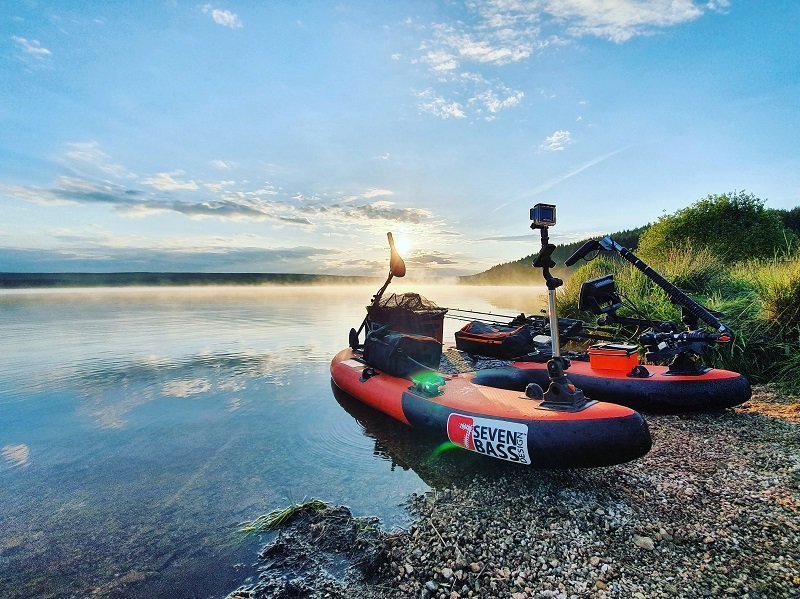
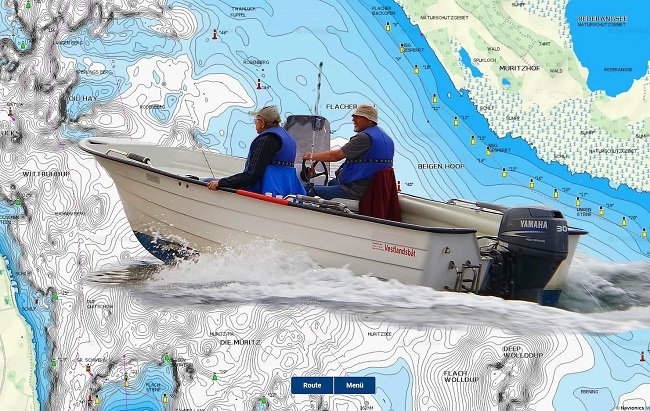
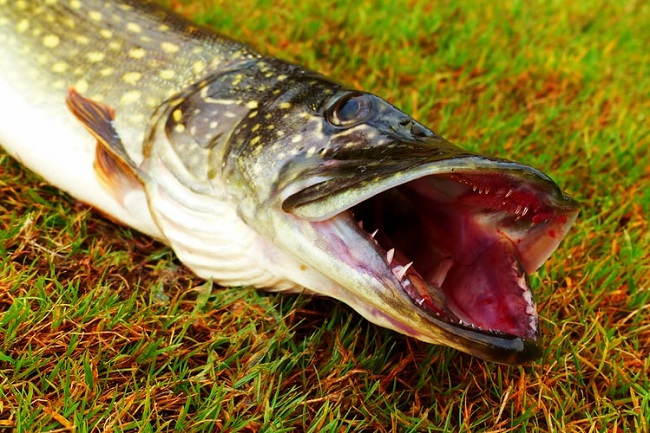
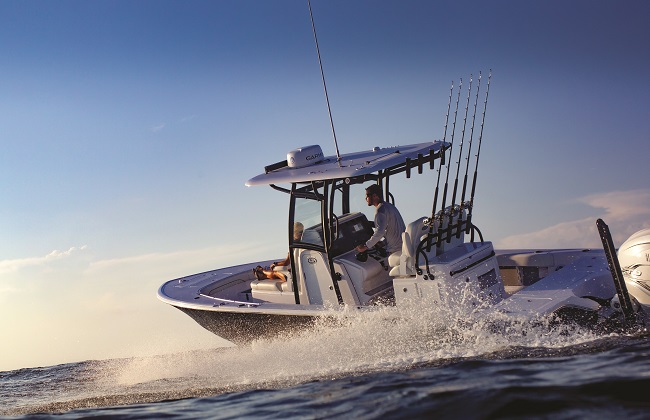
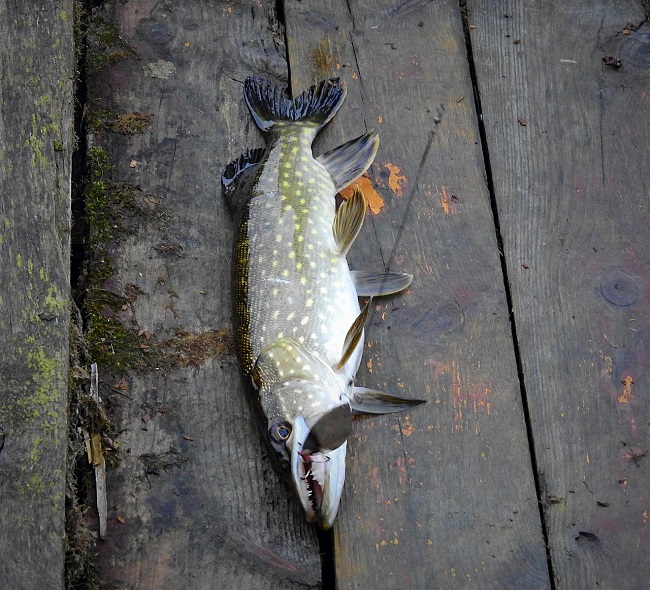
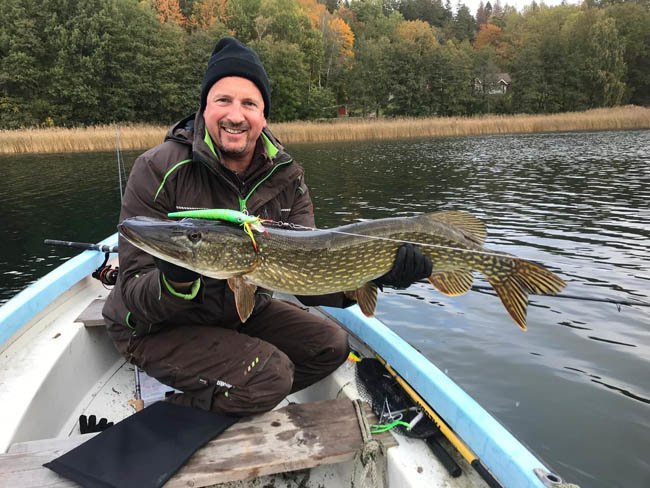

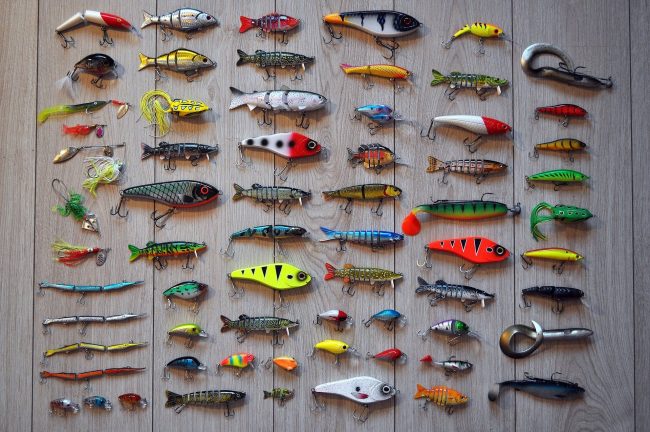
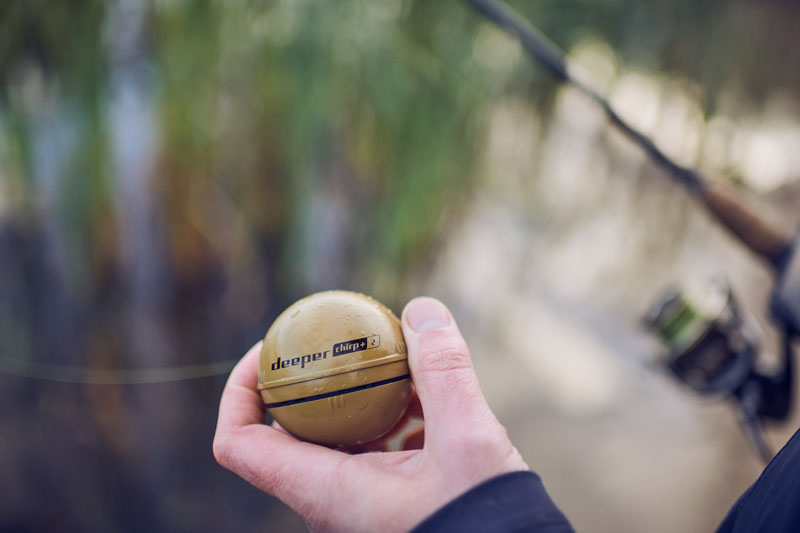
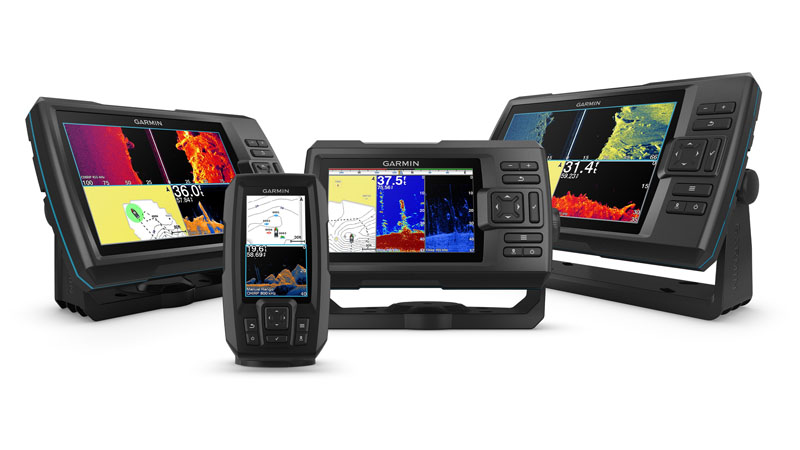
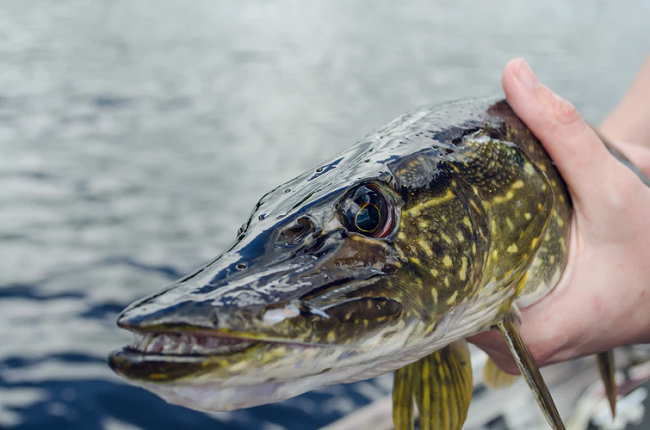
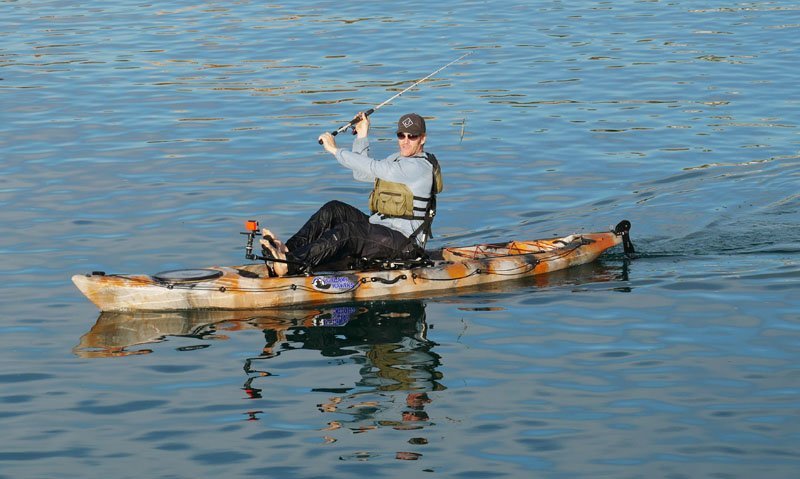
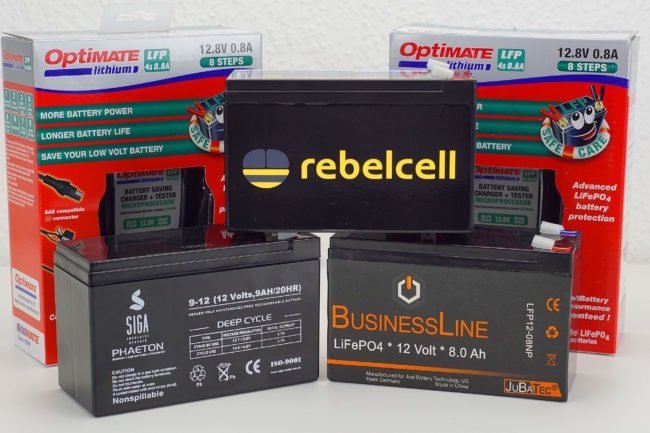
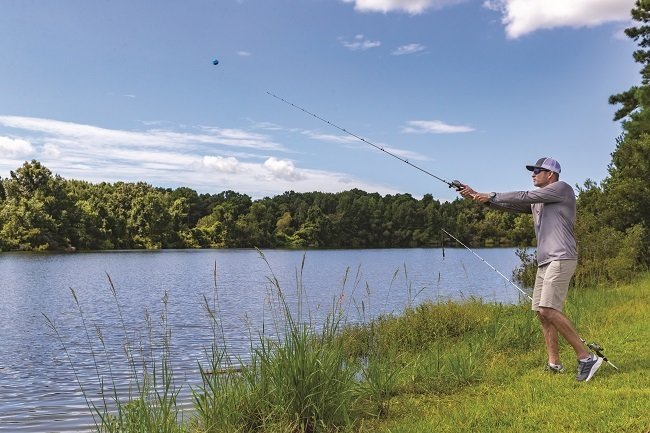
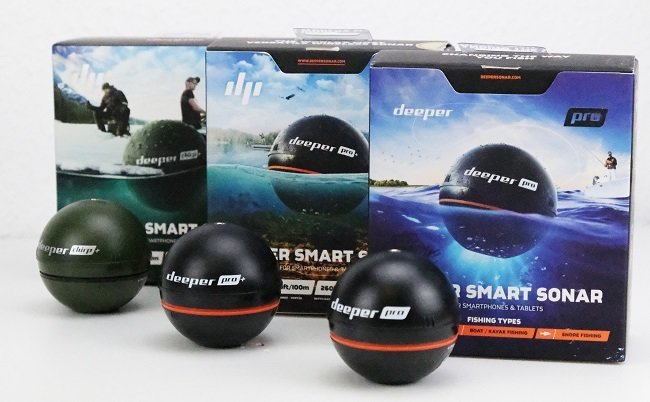

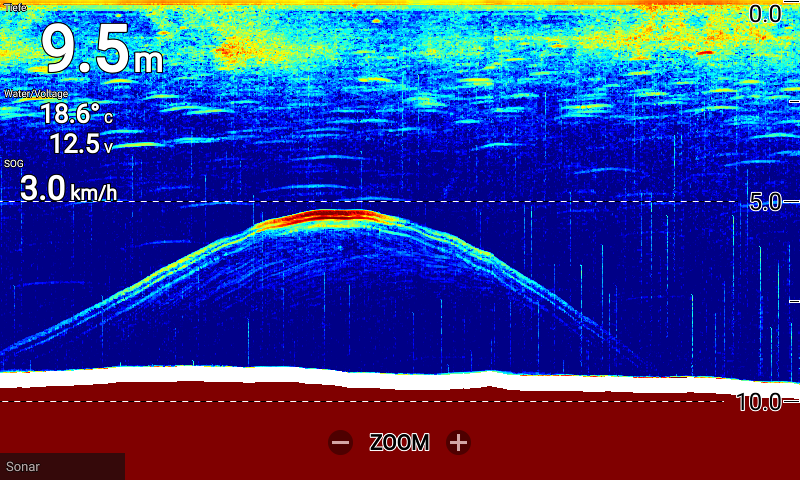
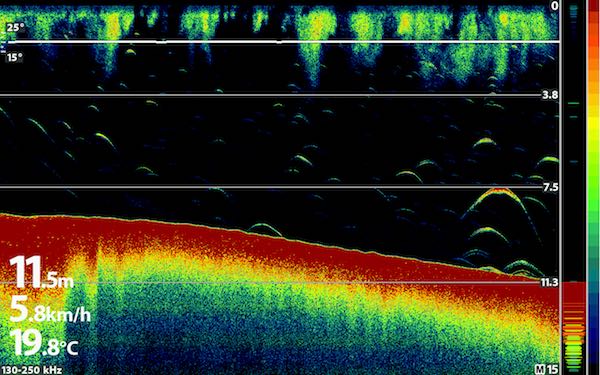
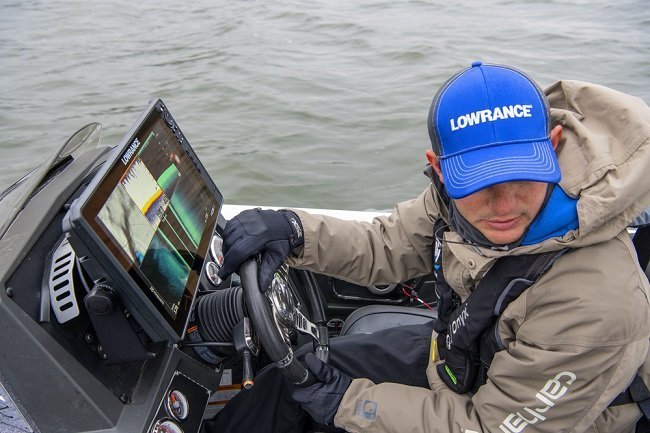
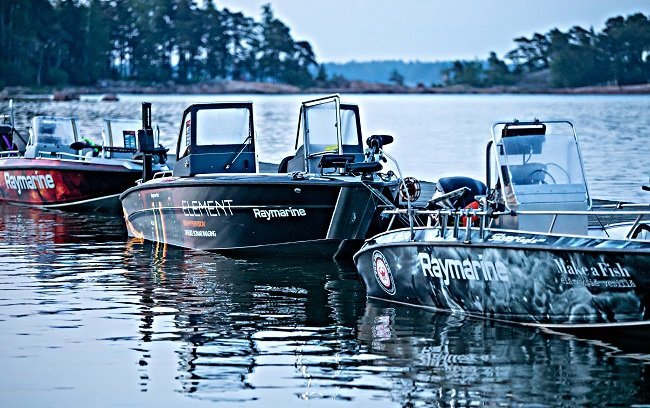
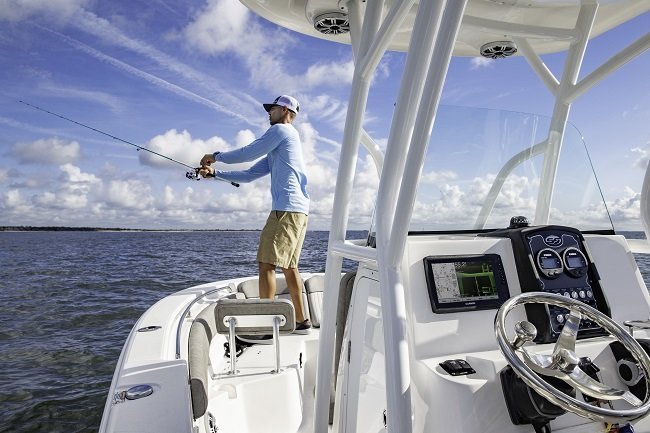
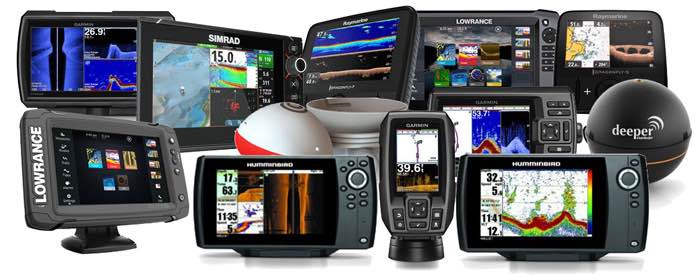
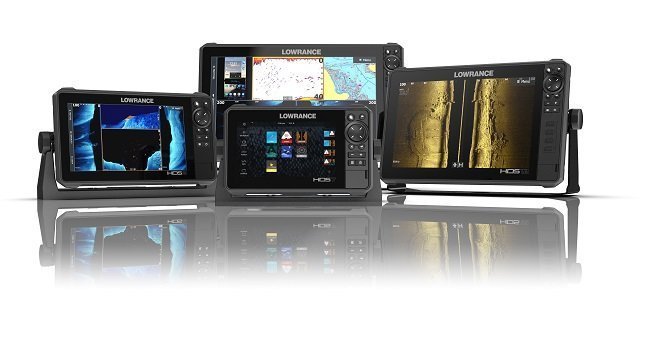
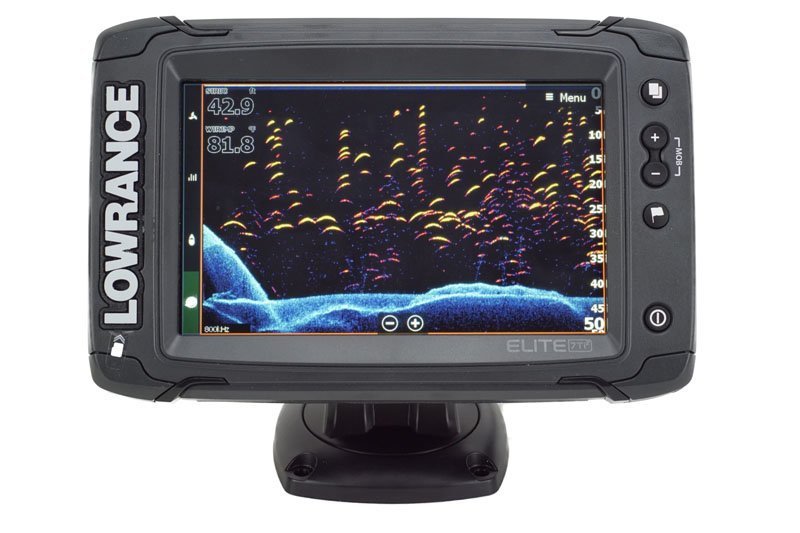
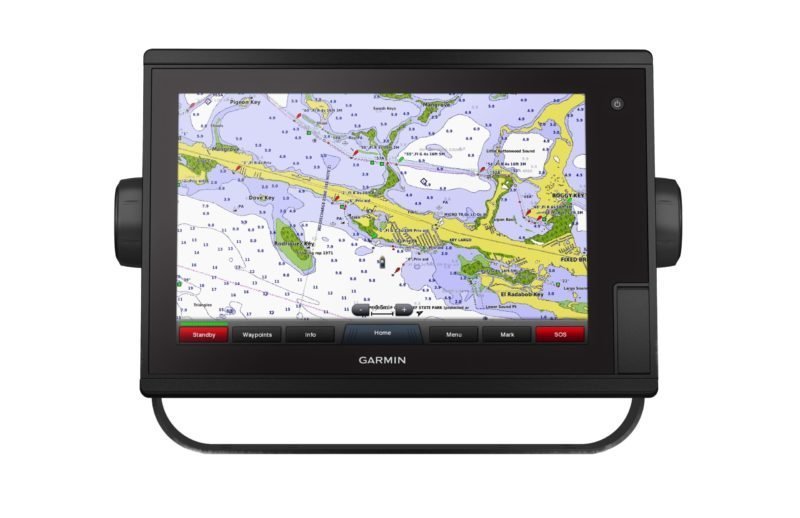
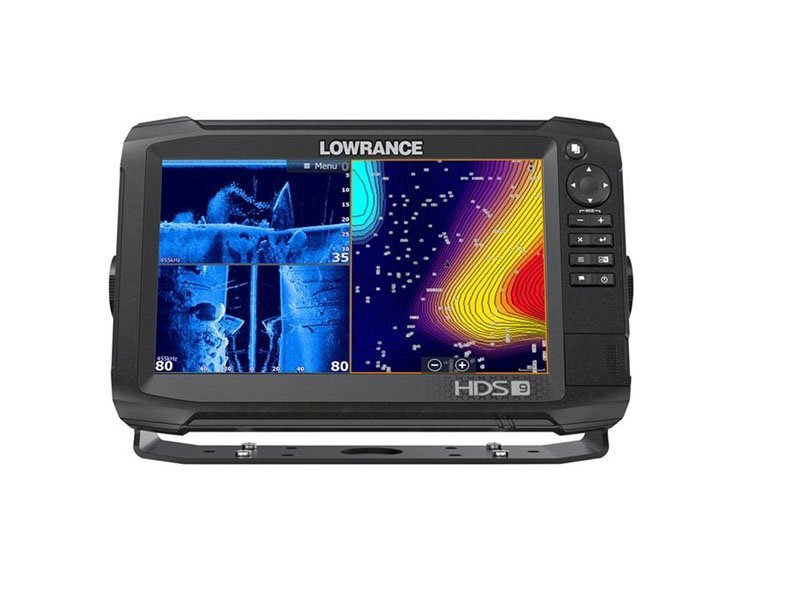
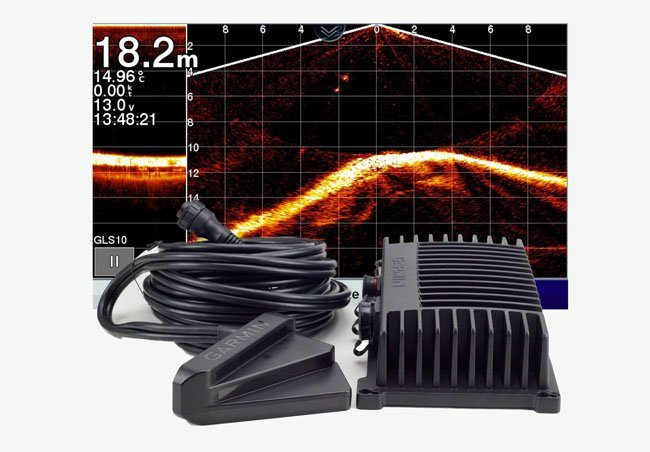
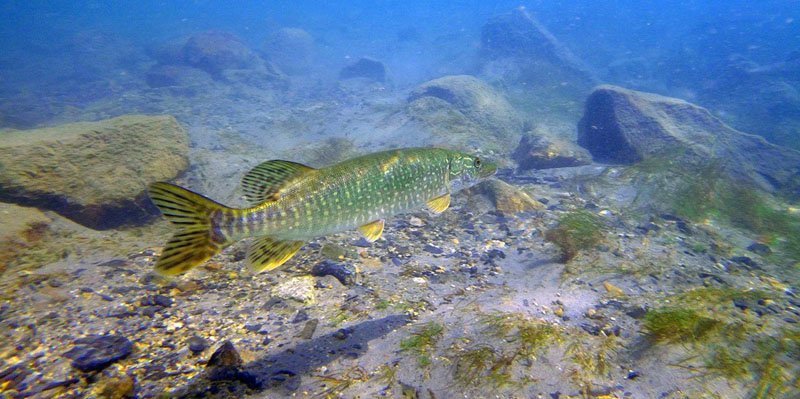
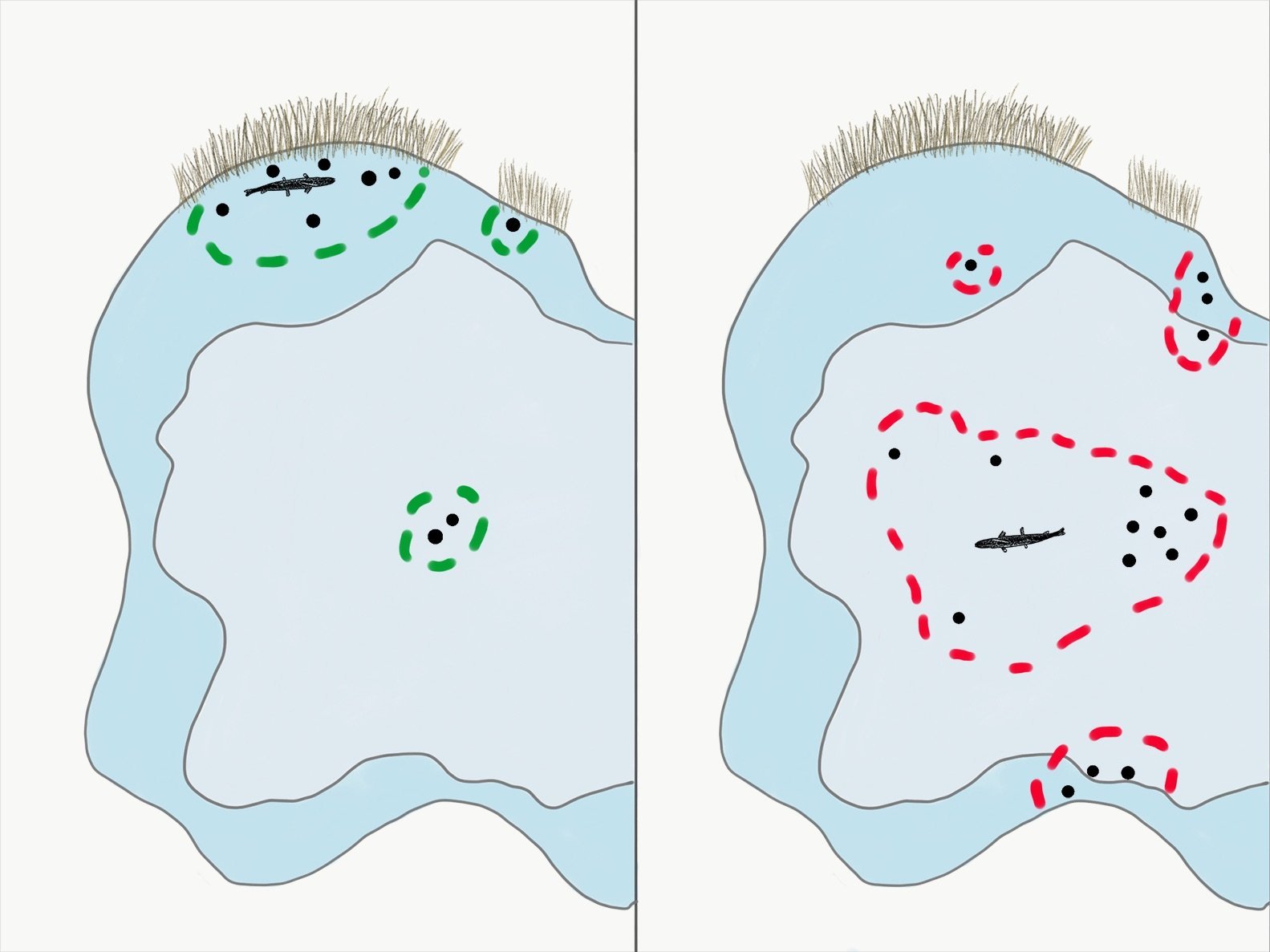
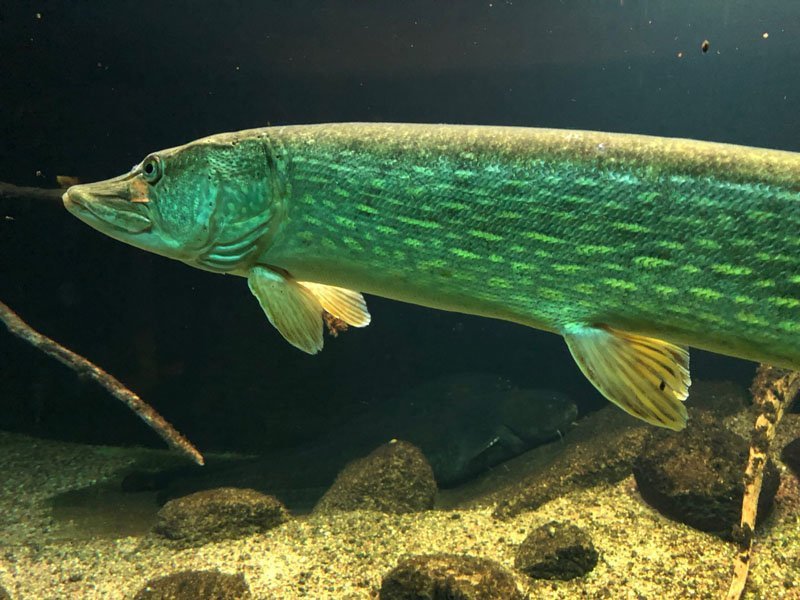
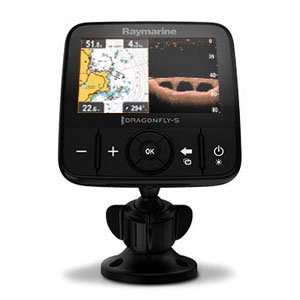
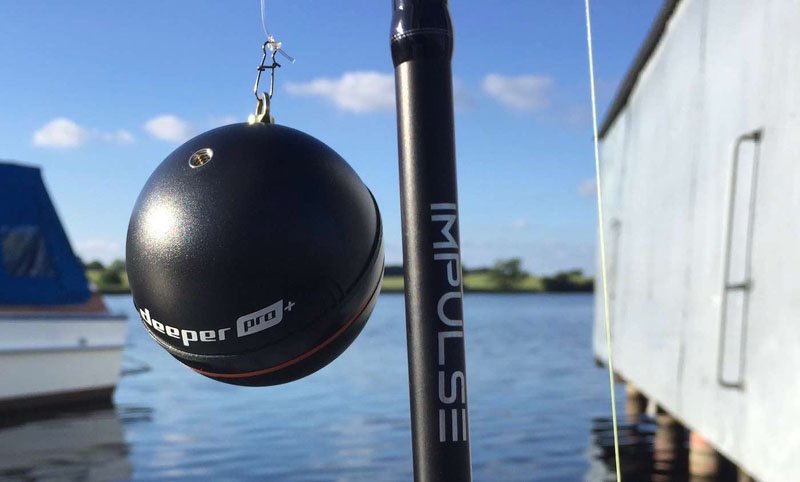
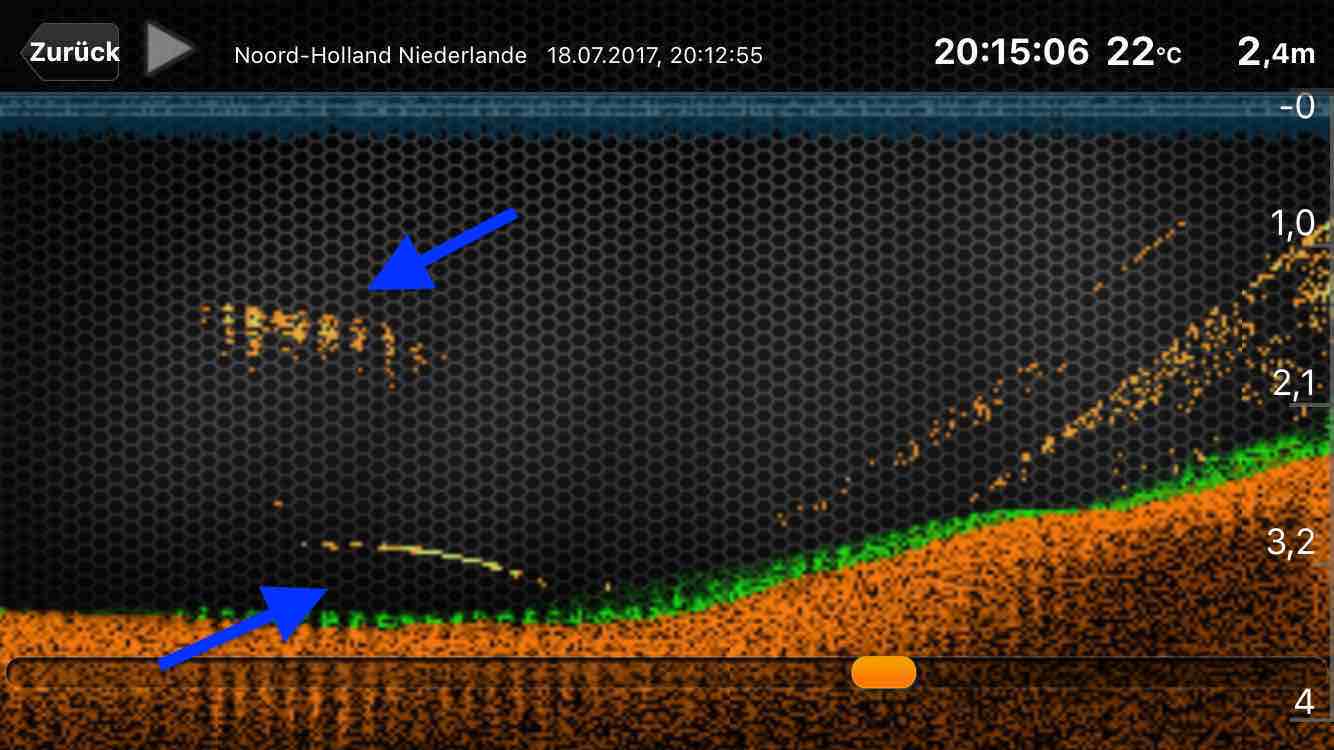
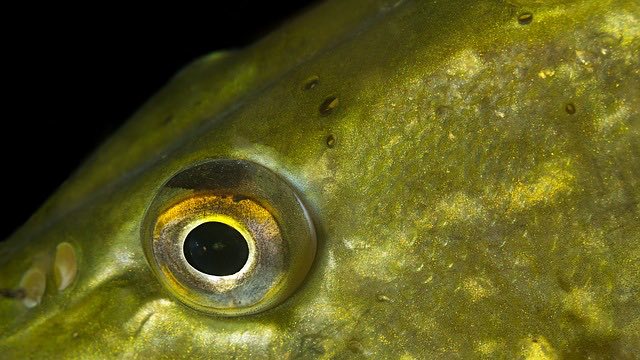


Raphaël G
Vladimir M
NICHOLAS JOHN REECY
Henrik
Dr. Manfred Marx
Andreas Witz
AK
Lübbe Wolfgang
Kalksee
Enrico Indelicato
Udo
Josef Weiss
Peter
Holger Just
Matthias Wappler
M. Hermanns
TACKLEFEVER